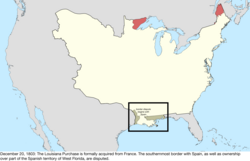This is an old revision of this page, as edited by Golbez (talk | contribs) at 19:42, 5 September 2018. The present address (URL) is a permanent link to this revision, which may differ significantly from the current revision.
Revision as of 19:42, 5 September 2018 by Golbez (talk | contribs)(diff) ← Previous revision | Latest revision (diff) | Newer revision → (diff)The United States of America was created on July 4, 1776, with the declaration of independence of thirteen British colonies. Their independence was recognized by Great Britain with the Treaty of Paris of 1783, following the American Revolutionary War. This effectively doubled the size of the colonies, now able to stretch west past the Proclamation Line to the Mississippi River. This land was organized into territories and then states, though there remained some conflict with the sea-to-sea grants claimed by some of the original colonies. In time, these grants were ceded to the federal government.
The first great expansion of the country came with the Louisiana Purchase of 1803, which doubled the country's territory, but brought it into minor conflict with the colonies of Spain which eventually resulted in the acquisition of Spanish Florida. The Oregon Country gave the United States access to the Pacific Ocean, though it was shared for a time with the United Kingdom. The annexation of the Republic of Texas in 1845 led directly to the Mexican–American War, after which the victorious United States obtained the northern half of Mexico's territory, including what was quickly made the state of California. However, as the development of the country moved west, the question of slavery became too much to ignore, as there was a struggle to keep the number of northern abolitionist states equal to the number of southern slave states, with vigorous debate over whether the new territories would allow slavery and events such as the Missouri Compromise and Bleeding Kansas. This came to a head in 1860 and 1861, when the governments of the southern states proclaimed their secession from the country and formed the Confederate States of America. The American Civil War led to the defeat of the Confederacy in 1865 and the eventual readmission of the states to the United States Congress.
The country's expansion beyond North America began in 1856 with the passage of the Guano Islands Act, causing many small and uninhabited, but economically important, islands in the Pacific Ocean and Caribbean Sea to be claimed. Most of these claims were eventually abandoned due to competing claims from other countries or the guano having been mined out. The Pacific expansion culminated in the overthrow of the Kingdom of Hawaii in 1893 and its annexation in 1898. Alaska, the last major acquisition in North America, was purchased from Russia in 1867.
Desires for expansion into Spanish territories like Cuba led to the Spanish–American War in 1898, in which the United States gained Guam, Puerto Rico, and the Philippines, and occupied Cuba for several years. American Samoa was acquired by the United States in 1900 after the end of the Second Samoan Civil War. The United States purchased the U.S. Virgin Islands from Denmark in 1917. Guam and Puerto Rico remain territories; the Philippines became independent in 1946, after being a major theater of World War II. Following the war, many islands were entrusted to the U.S. by the United Nations, and while the Northern Mariana Islands remain a U.S. territory, the Marshall Islands, Federated States of Micronesia, and Palau emerged from the trust territory as independent nations. The last major international change was the acquisition in 1904, and return to Panama in 1979, of the Panama Canal Zone, a region of American sovereignty to build and run the Panama Canal. The final cession of power over the region was made to Panama in 1999.
Regarding internal borders, while territories could shift wildly in size, once established states have generally retained their initial borders. Only four states – Maine, Kentucky, Vermont, and West Virginia – have been created from land claimed by another state; all of the others were created from territories or directly from acquisitions. Four states – Louisiana, Missouri, Nevada, and Pennsylvania – have expanded significantly by acquiring additional federal territory after their initial admission to the Union. The last state of the contiguous United States, commonly called the "lower 48," was admitted in 1912; the fiftieth and most recent state was admitted in 1959.
Table of changes
- Key to map colors
- United States states (domestic maps), undisputed area of United States (dispute maps)
- United States territories (domestic maps)
- disputed area of United States
- area changed by event
1776–1784 (American Revolutionary War)
| Date | Event | Change Map |
|---|---|---|
| July 4, 1776 | Thirteen colonies of the Kingdom of Great Britain in North America collectively declared their independence as the United States of America, though several colonies had already individually declared independence:
The capital was not specifically established; at the time, the Continental Congress met in Philadelphia. Many states had vaguely defined and surveyed borders; these are not noted as contested in the maps unless there was an active dispute. The borders of North Carolina were particularly poorly surveyed, its border with South Carolina having been done in several pieces, none of which truly matched the spirit of the charter, and its border with Virginia was only surveyed roughly halfway inland from the sea. Several northeastern states had overlapping claims: Connecticut, Massachusetts, and New York all claimed land west of their accepted borders, overlapping with each other and with a sizable claim by Virginia. Of the three, only Connecticut seriously pursued its claims, while Virginia is considered to have had the most legitimate claim to the vast northwest, dividing it into counties and maintaining some limited control. The entirety of the new United States was claimed by Great Britain. Of particular note are Machias Seal Island and North Rock, two small islands off the northeast coast which remain disputed up to the present. |
 Disputes: |
| September 20, 1776 | The Counties of New Castle, Kent, and Sussex, upon Delaware enacted a constitution, renaming itself the Delaware State. | 
|
| September 28, 1776 | The State of Pennsylvania enacted a constitution, renaming itself the Commonwealth of Pennsylvania. | no change to map |
| December 20, 1776 | To avoid British forces who were advancing on Philadelphia, the Continental Congress began meeting in Baltimore. | 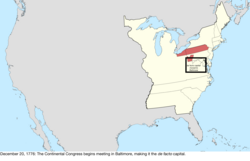
|
| January 15, 1777 | The northeastern region of New York, known as the New Hampshire Grants, declared independence as New Connecticut. | Disputes: |
| March 4, 1777 | The Continental Congress returned to Philadelphia after the threat to it by British forces was ended. | 
|
| June 4, 1777 | New Connecticut was renamed Vermont. | Disputes: |
| September 27, 1777 | The Continental Congress fled Philadelphia after the American defeat at the Battle of Brandywine, and briefly met in Lancaster, Pennsylvania | 
|
| September 30, 1777 | The Continental Congress continued to move away from Philadelphia, settling in York, Pennsylvania. | 
|
| June 11, 1778 | Vermont claimed what was called the "East Union," consisting of some towns in New Hampshire that petitioned on March 12, 1778, to join with Vermont due to a concern that their state was focusing too much on its coastal region. Vermont never gained full control over the area. The specific extent of the towns annexed is unknown, as township borders were often delineated only when a dispute arose; the map uses the maximal interpretation. | Disputes:
|
| October 21, 1778 | Due to pressure from the Continental Congress, Vermont rescinded the annexation of the East Union; the legislature declared on February 12, 1779, that the East Union should be considered null from its beginning. | Disputes:
|
| July 2, 1779 | The Continental Congress returned to Philadelphia following British withdrawal. | 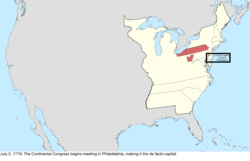
|
| August 31, 1779 | Virginia surrendered its claim to southwest Pennsylvania when the two states agreed to extend the Mason–Dixon line westward to five degrees west of the Delaware River, with the border turning north from there. | 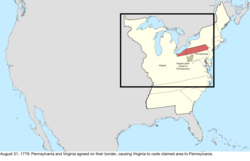
|
| March 1780 | North Carolina and Virginia surveyed their border further inland. Virginia's survey reached to the Tennessee River, but North Carolina's only went as far as the Cumberland Gap, and as the two surveys were roughly two miles apart, this created a thin area claimed by both states. Since the dispute only technically went as far west as the Cumberland Gap, beyond that point North Carolina's line is faded to show that it was more an assumption, and beyond the Tennessee River both lines are faded. While the border was intended to follow parallel 36°30′ north, early surveying errors caused it to veer north of that, reaching a distance of seventeen miles off by the time it reached the Tennessee River. | 
|
| October 25, 1780 | The State of Massachusetts Bay enacted a constitution, renaming itself the Commonwealth of Massachusetts. | 
|
| March 1, 1781 | The Articles of Confederation entered into force. | no change to map |
| April 4, 1781 | Vermont again claimed an East Union, consisting of some towns in New Hampshire that wished to join with Vermont; more towns were interested than during the first attempt in 1778, though again, the exact extent of the borders is unknown. Vermont never gained full control over the area. | Disputes:
|
| June 16, 1781 | Vermont claimed what was called the "West Union," consisting of some towns in New York, mainly to counterbalance Vermont's attempt at eastward expansion. Vermont never gained full control over the area. The specific date this occurred is unclear; sources suggest June 16, June 26, and July 18. | Disputes:
|
| February 22, 1782 | Vermont abandoned its attempts to annex the East Union from New Hampshire and the West Union from New York. | Disputes:
|
| October 29, 1782 | The federal government accepted the cession from New York of its western claims, which the state ceded on February 17, 1780. New York proclaimed its new western border to be a line drawn south from the western end of Lake Ontario; at its maximum interpretation, the state claimed an area bordered by Lake Erie, Lake Huron and Lake Michigan; to the Illinois, Mississippi, and Tennessee Rivers; and north along the Appalachian Mountains, ending at the border with Pennsylvania. It is unclear from where this claim came; many sources state that New York had surrendered it, but very few elaborate on how it was obtained. One source states that it was a cession by the Six Nations, who had conquered much of the region. However, New York never seriously enforced these claims. The cession included the small tip of New York north of Pennsylvania, the Erie Triangle. | 
|
| December 30, 1782 | The Congress of the Confederation declared that the land that Connecticut claimed in northern Pennsylvania was part of Pennsylvania, thus attempting to end the Pennamite–Yankee War. The claim was an extension of Connecticut's northernmost and southernmost borders westward, skipping New Jersey and New York, though as Connecticut's northern border was a few miles north of Pennsylvania's northern border, a small sliver of New York was also claimed. While conflict would continue for some time, this was the end of the formal claim by Connecticut. | 
|
| June 30, 1783 | The Pennsylvania Mutiny of 1783, and the Pennsylvania government reaction to it, caused the Congress of the Confederation to leave Philadelphia for Princeton. | 
|
| November 26, 1783 | The Congress of the Confederation reconvened in Annapolis. | 
|
| March 1, 1784 | Virginia ceded its claims northwest of the Ohio River to the federal government. Connecticut continued to claim its western lands that had overlapped Virginia's cession. | 
|
| May 12, 1784 | Great Britain recognized the independence of the United States, ending its claim to the country. The treaty ended the American Revolutionary War, though military action had largely ended after the Franco-American victory at Yorktown on October 19, 1781.
Because of ambiguities and poor knowledge of geography, the treaty was unclear in several areas:
The Peace of Paris also involved treaties with France and Spain, with Great Britain ceding the Floridas to Spain. During their ownership of West Florida, the British had moved its border north, and the cession to Spain appeared to apply to the full extent of the British colony. However, the British-American treaty granted the extension of West Florida to the United States, where it enlarged Georgia south to the 31st parallel north, indicating that only the original definition of West Florida was to be ceded to Spain. The local Spanish governors also made a move to occupy forts along the Mississippi River, with claims to everything south of the Tennessee River; it is unknown how official or strong these claims were, and they are not mapped as they are in conflict with the other Spanish claim involving the border of West Florida. |
 Disputes: 
|
1784–1803 (Organization of territory)
| Date | Event | Change Map |
|---|---|---|
| August 23, 1784 | A region in central North Carolina, unhappy with the state's governance over the area, declared independence from the state as the State of Frankland. The government of Frankland held some control over the area, and petitioned for statehood, receiving support from seven of the nine states required, but would only last a few years. | Unofficial change:
|
| November 1, 1784 | The Congress of the Confederation moved for a short time to Trenton. | 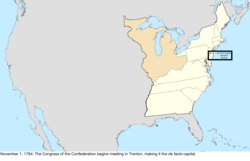
|
| January 11, 1785 | The Congress of the Confederation moved to New York, and would settle there for five years. | 
|
| April 19, 1785 | The federal government accepted the cession from Massachusetts of its extreme western claim, which consisted of a strip of land west of Lake Huron and the Detroit River, bounded on the north by a line extending west from roughly halfway north through New Hampshire, which was the maximal interpretation of Massachusetts Bay's colonial borders, and on the south by a line extending from the state's southwest corner. The claim was never seriously enforced. | Change on paper only:
|
| June 1785 | The State of Frankland was renamed the State of Franklin, to encourage Benjamin Franklin to endorse the state, though he declined. | Unofficial change:
|
| September 13, 1786 | Connecticut surrendered its western claim to the federal government except for its Western Reserve, though it is unclear how much control they held over the ceded region; like the claim to Pennsylvania, this was a western extension of Connecticut's northernmost and southernmost points. | Change on paper only:
|
| December 16, 1786 | Massachusetts surrendered its claim to western New York, though it is unclear if Massachusetts ever held control over the region, as the claim was to the "soil, not the sovereignty". This land, which was the area west of a north-south line 82 miles west of where the Delaware River entered New York, was later known as the Phelps and Gorham Purchase. It is likely that Massachusetts also claimed the Erie Triangle, but since this treaty was directly with New York, and New York had already ceded it to the federal government, it is not marked as being ceded by Massachusetts on the map. | Change on paper only:
|
| July 13, 1787 | The Territory Northwest of the Ohio River, ceded earlier by Virginia, was organized and commonly became known as the Northwest Territory. | 
|
| August 9, 1787 | South Carolina ceded its western claim to the federal government, though it was a result of inaccurate geography and South Carolina never actually held claim to this land. The claim was of a strip of land between the border of North Carolina and the source of the Savannah River but, unknown at the time, the river originated in North Carolina. The eastern part of this cession would be given to Georgia in 1802, despite Georgia technically already having claim to the land. | Change on paper only:
|
| December 7, 1787 | Delaware became the first state to ratify the United States Constitution. | no change to map |
| December 12, 1787 | Pennsylvania became the second state to ratify the Constitution. | no change to map |
| December 18, 1787 | New Jersey became the third state to ratify the Constitution. | no change to map |
| January 2, 1788 | Georgia became the fourth state to ratify the Constitution. | no change to map |
| January 6, 1788 | Connecticut became the fifth state to ratify the Constitution. | no change to map |
| February 6, 1788 | Massachusetts became the sixth state to ratify the Constitution. | no change to map |
| April 28, 1788 | Maryland became the seventh state to ratify the Constitution. | no change to map |
| May 23, 1788 | South Carolina became the eighth state to ratify the Constitution. | no change to map |
| June 21, 1788 | New Hampshire became the ninth state to ratify the Constitution; at this point, the Constitution became the active governing document of the country. | no change to map |
| June 25, 1788 | Virginia became the tenth state to ratify the Constitution. | no change to map |
| July 26, 1788 | New York became the eleventh state to ratify the Constitution. | no change to map |
| February 1789 | John Sevier, governor of the State of Franklin, pledged allegiance to North Carolina, effectively ending the claimed independence of Franklin. | Unofficial change: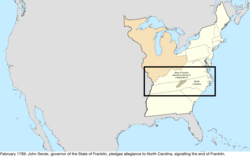
|
| August 7, 1789 | The Northwest Territory was reorganized under the Constitution. | no change to map |
| November 21, 1789 | North Carolina became the twelfth state to ratify the Constitution. | no change to map |
| April 2, 1790 | North Carolina ceded its western half to the federal government. | 
|
| May 26, 1790 | The land recently ceded by North Carolina was organized as the Territory South of the River Ohio, commonly known as the Southwest Territory. | 
|
| May 29, 1790 | Rhode Island became the thirteenth state to ratify the Constitution. | no change to map |
| December 6, 1790 | Per the Residence Act, the Congress of the United States relocated to Philadelphia for ten years until a federal district was built and ready. | 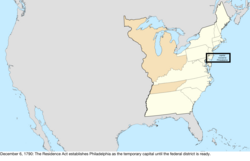
|
| March 4, 1791 | Vermont, which had been considered part of New York despite acting independently since 1777, was admitted as the fourteenth state. |  Disputes: 
|
| March 30, 1791 | The District of Columbia, a federal district planned to house the federal government by 1800, was formed from land ceded by Maryland and Virginia, consisting of a 100 square mile diamond straddling the Potomac River. However, it was not yet given that name, being simply referred to as the federal district. In September 1791, the commissioners in charge of planning the city would term it the "Territory of Columbia", and various laws refer to a District of Columbia, but sometimes informally. The area does not appear to have been formally named "District of Columbia" until at least the organic act of 1871. Since the name "Columbia" was used from very early on, and at least informally by the government, the map will use "District of Columbia" starting from this date. | 
|
| March 3, 1792 | Pennsylvania purchased the Erie Triangle from the federal government. | 
|
| June 1, 1792 | The western half of Virginia, which the state had agreed in 1789 to cede to the federal government, was admitted as the fifteenth state, Kentucky. | 
|
| June 12, 1792 | The Delaware State enacted a new constitution, renaming itself the State of Delaware. | no change to map |
| February 29, 1796 | Great Britain agreed to abandon several forts in the northwest that it still occupied, including Detroit. The treaty also provided for commissions to determine the border between the northwestern point of the Lake of the Woods and the source of the Mississippi River, and which river to consider the St. Croix River. | no change to map |
| April 25, 1796 | The northern half of West Florida was ceded by Spain, resolving the dispute over the region. | Disputes:
|
| June 1, 1796 | The Southwest Territory was admitted as the sixteenth state, Tennessee. | 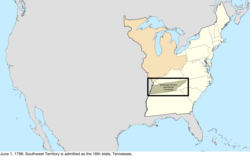
|
| April 7, 1798 | Due to the Yazoo Land Fraud, an act authorized President John Adams to appoint commissioners to negotiate with Georgia about ceding its western land. The act created Mississippi Territory from the southwestern quarter of Georgia in the region recently ceded by West Florida, while maintaining that Georgia still held rights over the territory. | 
|
| October 25, 1798 | Commissioners agreed on the source of the St. Croix River, setting the lower portion of the border between Massachusetts and Great Britain and, thus, where the eastern north-south line originated. |  Disputes: 
|
| June 9, 1800 | Connecticut ceded its Western Reserve to the federal government, which assigned it to the Northwest Territory. The act doing so was passed in Congress on April 28, 1800, and Connecticut approved it on this date. | 
|
| July 4, 1800 | Indiana Territory was organized from the Northwest Territory, west of a line from the mouth of the Kentucky River to Fort Recovery, and a line north from there. | 
|
| November 17, 1800 | The Congress of the United States moved to Washington in the District of Columbia, now built and ready to be the capital. This was two weeks before the December 1 date established in the Residence Act; President John Adams urged Congress to move early in hopes of securing enough Southern votes to be re-elected, though this failed. | 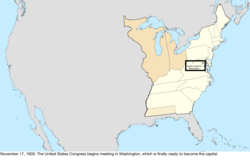
|
| January 1, 1801 | The Kingdom of Great Britain united with the Kingdom of Ireland, renaming itself the United Kingdom. | 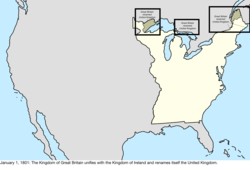
|
| February 27, 1801 | The District of Columbia was organized. | no change to map |
| April 26, 1802 | Georgia ceded its western half, known as the Yazoo Lands, to the federal government; this region was west of the Chattahoochie River up to its great bend (near West Point), then a line from there towards and past Nickajack. At the same time, the federal government ceded to Georgia the eastern portion of the land previously ceded by South Carolina, though in reality Georgia technically already held title to the land, as the description of the earlier cession was based on an erroneous understanding of geography. | 
|
| March 1, 1803 | The southern half of the Northwest Territory, along with a thin sliver of Indiana Territory, was admitted as the seventeenth state, Ohio. The remainder of the Northwest Territory was transferred to Indiana Territory. The western border was a line due north from the mouth of the Great Miami River to a point east from the southern tip of Lake Michigan. The federal description then said it should go east from there, whereas the Ohio Constitution stated it should intersect with the most northerly cape of Maumee Bay, essentially the western tip of Lake Erie. The confusion caused by these varying descriptions of the state's borders, combined with inaccurate knowledge of geography, as no one at the time knew just how far south Lake Michigan extended, would lead to the conflict over the Toledo Strip. | 
|
| November 3, 1803 | The border between Tennessee and Virginia was resurveyed and established, ending the dispute over that part of the border. The border between Kentucky and Tennessee, despite following the original survey, remained vaguely defined. | 
|
1803–1818 (Purchase of Louisiana)
| Date | Event | Change Map |
|---|---|---|
| December 20, 1803 | The United States purchased Louisiana from France. This is the date of the formal turnover in New Orleans; the purchase was completed on April 30, 1803. The transfer would be recognized in St. Louis in Upper Louisiana on March 10, 1804, known as Three Flags Day.
The extent of what constituted Louisiana was disputed with Spain: the United States claimed the purchase included the part of West Florida west of the Perdido River, and the southwestern border with New Spain was disputed, as the United States claimed the Sabine River as the border, but Spain maintained it was the Calcasieu River and others. |
 Disputes: |
| 1804 | The "Southwick Jog" was transferred from Connecticut to Massachusetts, to put to rest long-standing disagreements over the border between the two states. | 
|
| March 27, 1804 | The land between Tennessee and Mississippi Territory previously ceded by Georgia was assigned to Mississippi Territory. | 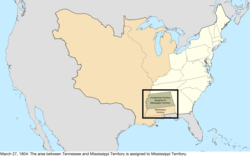
|
| October 1, 1804 | Orleans Territory was organized from the Louisiana Purchase south of the 33rd parallel north, with the remainder being designated the District of Louisiana and placed under the jurisdiction of Indiana Territory. | 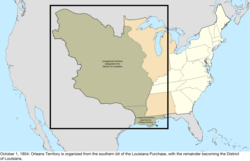
|
| June 30, 1805 | Michigan Territory was organized from Indiana Territory, defined as north of a line east from the southern tip of Lake Michigan, and east of a line north from the lake's northern tip. The southeastern portion of the border technically conflicted with the definition of Ohio, which claimed the Toledo Strip north of that line; however, the exact position of Lake Michigan was not yet known. | 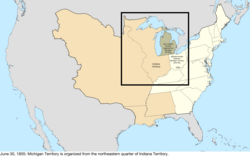
|
| July 4, 1805 | The District of Louisiana was organized as Louisiana Territory. | 
|
| March 1, 1809 | Illinois Territory was organized from Indiana Territory, west of the Wabash River and a line north from Post Vincennes. | 
|
| September 26, 1810 | The Republic of West Florida declared independence from Spain. It maintained some control over its territory. | Disputes:
|
| December 10, 1810 | Armed forces led by William C. C. Claiborne took possession of the portion of West Florida west of the Pearl River, following a proclamation on October 27, 1810, by President James Madison to do so. The United States had considered the region part of the Louisiana Purchase, including the area which had revolted against Spanish Florida and formed the Republic of West Florida. Madison's proclamation stated that it was to be "taken as part" of Orleans Territory. The land west of Mobile Bay to the Pearl River was occupied and annexed de facto by the military in 1811. | Disputes:
|
| April 30, 1812 | Most of Orleans Territory was admitted as the eighteenth state, Louisiana. It was defined as the portion of the territory east of a line north from where the Sabine River crosses the 32nd parallel north, and west of the Mississippi and Iberville Rivers. The remainder presumably became unorganized territory, as it had no definition for a while. | 
|
| May 14, 1812 | The claimed portion of West Florida east of the Pearl River was assigned to Mississippi Territory, though the area around Mobile Bay remained under the control of Spanish Florida. The United States militarily occupied Mobile and the surrounding area up to the Perdido River in April 1813. | 
|
| June 4, 1812 | Since its name was now shared with the state of Louisiana, Louisiana Territory was renamed Missouri Territory. | 
|
| August 4, 1812 | The remaining claimed portion of West Florida was added to Louisiana, following the assent of that state to an act passed by Congress on April 14, 1812. | 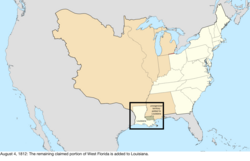
|
| August 16, 1812 | During the War of 1812, the garrison at Fort Detroit surrendered, leading the United Kingdom to occupy Detroit, the capital and population center of Michigan Territory. | Disputes:
|
| September 29, 1813 | Fort Detroit was recaptured by American forces following the Battle of Lake Erie, regaining control over Michigan Territory. | Disputes:
|
| August 24, 1814 | British forces capture and burn Washington, but are forced to withdraw the next day. The functions of the capital were only momentarily suspended, though President James Madison took refuge in Brookville, Maryland. | no change to map |
| December 11, 1816 | The southern part of Indiana Territory, along with small parts of Illinois Territory and Michigan Territory, were admitted as the nineteenth state, Indiana. The state was defined as the territory north of the Ohio River and east of the Wabash River, but while the territory's line turned north at Post Vincennes, the state's border continued up the Wabash until it reached the point where a line drawn north from Post Vincennes would last intersect the river as it weaved back and forth. The northern border of the state was a line east from 10 miles north of the southern tip of Lake Michigan, until it reached the meridian that formed Ohio's western border. Thus, a very small portion of Indiana Territory was transferred to Illinois Territory around the Wabash, Indiana took its northern slice from Michigan Territory, and the remainder of Indiana Territory across Lake Michigan became unorganized territory. | 
|
| March 3, 1817 | Alabama Territory was organized from the eastern half of Mississippi Territory. Its western border was, from the north: the Tennessee River to Bear Creek (around today's Pickwick Lake); a line from there to the northwestern corner of Washington County, Mississippi Territory; and a line south from there. | 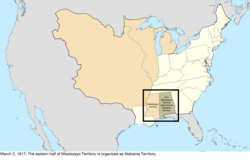
|
| December 10, 1817 | Mississippi Territory was admitted as the twentieth state, Mississippi. | 
|
| February 6, 1818 | Alabama Territory created Tuskaloosa County with a description that inadvertently overlapped with Mississippi. It described the border of the county as running "a due west course to, the Tombeckbe river; thence up the same to the Cotton Gin Port". Unknown at the time, the origin of the Tombigbee River and Cotton Gin Port were in Mississippi. | Change on paper only:
|
| June 30, 1818 | Per the terms of the Treaty of Ghent ending the War of 1812, the United Kingdom returned Moose Island to Massachusetts, and the United States returned Campobello Island, Deer Island, and Grand Manan Island to the United Kingdom, all of which were captured from the other side during the war. | no change to map |
| December 3, 1818 | The half of Illinois Territory south of the parallel 42°30′ north was admitted as the twenty-first state, Illinois. The remainder of the territory, along with the unorganized territory that was recently part of Indiana Territory, was assigned to Michigan Territory. | 
|
1819–1845 (Northwest expansion)
| Date | Event | Change Map |
|---|---|---|
| January 30, 1819 | The Treaty of 1818 went into effect, setting the 49th parallel north as the border with the United Kingdom west of the Lake of the Woods, and also establishing the Oregon Country as a shared region with the United Kingdom. Oregon Country had no defined northern limit, but it can be assumed that it did not encroach much upon Russian-held lands; this map uses the later-established line at the parallel 54°40′ north for simplicity. | 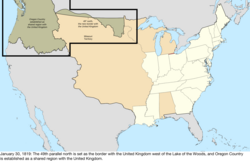 Northwestern North America: 
|
| July 4, 1819 | Arkansaw Territory was organized from Missouri Territory south of the parallel 36°30′ north. | 
|
| December 14, 1819 | Alabama Territory was admitted as the twenty-second state, Alabama. The statehood act provided for a survey of the southern part of the border with Mississippi for correction if it was discovered to encroach upon Mississippi's defined borders; it was later discovered to do so. | 
|
| March 15, 1820 | As part of the Missouri Compromise, the District of Maine, the northern and separate part of Massachusetts, was admitted as the twenty-third state, Maine. | 
|
| April 21, 1820 | This is the earliest known date of the name "Arkansas Territory" being officially used instead of "Arkansaw Territory". | 
|
| May 12, 1820 | The border between Kentucky and Tennessee was established. To make up for the fact that the border between the Cumberland Gap and the Tennessee River veered north as much as 17 miles from 36°30′ north, a new survey was conducted starting at that point on the Mississippi River and moving east to the Tennessee River, hence granting Kentucky an addition in its southwest. | 
|
| July 19, 1820 | The overlap of the longitudinal southern border between Alabama and Mississippi was resolved, as per the act admitting Alabama as a state, because the provisional border encroached on Mississippi. As the result of a survey, the southern border terminus was moved about 3.8 miles to the east, which changed the border up to the then-northwest corner of Alabama's Washington County. The date when this happened is unclear; the sources available give either an unpublished report dated May 29, 1820, or the completion of the demarcation of the new line on July 19, 1820. | Change on paper only:
|
| December 19, 1820 | Alabama redefined some county borders, ending its erroneous overlap of Mississippi created on February 6, 1818. | Change on paper only: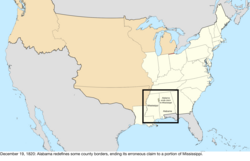
|
| February 22, 1821 | The Adams–Onís Treaty with Spain took effect. The many changes included:
|
 Disputes: 
|
| July 10, 1821 | East Florida was formally transferred to the United States by Spain. | 
|
| July 17, 1821 | West Florida was formally transferred to the United States by Spain. | 
|
| August 10, 1821 | The southeastern corner of Missouri Territory was admitted as the twenty-fourth state, Missouri, the rest becoming unorganized territory. It was defined as the area south of a line west from the Des Moines Rapids, and east of a line south from the mouth of the Kansas River. | 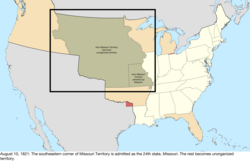
|
| March 30, 1822 | The former East Florida and West Florida were organized as Florida Territory. | 
|
| May 26, 1824 | The western half of Arkansas Territory, bordered by a line south from a point 40 miles west of Missouri's western border, was returned to unorganized territory. | 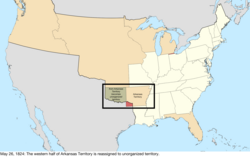
|
| January 12, 1825 | A treaty with the Russian Empire established the parallel 54°40′ north as the northern border of Oregon Country for American purposes; a separate treaty created the same border between Russia and the United Kingdom. As this was likely the de facto border anyway, the region is already mapped with this line. | no change to map |
| May 6, 1828 | A treaty with the Cherokee moved the western border of Arkansas Territory, returning part of it to unorganized territory. The new border was defined as starting from where the land of the Eastern Choctaw met the Red River of the South, then north from there to the mouth of the Arkansas River, and from there to the southwestern corner of Missouri. | 
|
| January 20, 1831 | King William I of the Netherlands, having been asked per the Treaty of Ghent to arbitrate the disputed border between Maine and the United Kingdom, rendered his decision: Since reconciling the treaty with the maps given was too difficult, he drew a compromise line. The British government accepted it, but Maine protested, and on January 19, 1832, the American government rejected it. | no change to map |
| July 9, 1832 | The northernmost region of New Hampshire, which was disputed with the United Kingdom, declared independence as the Republic of Indian Stream. While tiny, it does appear to have maintained some control over its territory. | Disputes: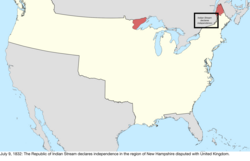
|
| June 28, 1834 | Michigan Territory gained a large parcel of land from unorganized territory on its west, extending to the Missouri River. | 
|
| August 5, 1835 | The Republic of Indian Stream recognized the jurisdiction of New Hampshire, thus ending its claimed independence. The date given is of a communication sent to British authorities; other sources note a resolution passed by the citizens of Indian Stream on April 2, 1836. | Disputes:
|
| June 15, 1836 | Arkansas Territory was admitted as the twenty-fifth state, Arkansas. | 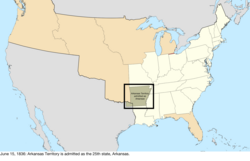
|
| July 3, 1836 | Wisconsin Territory was organized from the western bulk of Michigan Territory. The two large peninsulas between the Great Lakes remained in Michigan Territory; the upper peninsula was included in exchange for the territory abandoning its claim to the Toledo Strip. The territory initially rejected this plan, but would accept it on December 14. | 
|
| December 14, 1836 | Michigan Territory agreed to abandon its claim to the Toledo Strip, ending its dispute with Ohio. | 
|
| January 26, 1837 | Michigan Territory was admitted as the twenty-sixth state, Michigan. | 
|
| March 28, 1837 | The Platte Purchase transferred some land from unorganized territory to northwest Missouri, extending its northern border west to the Missouri River. | 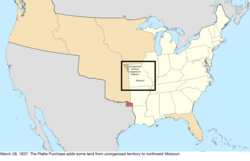
|
| July 3, 1838 | Iowa Territory was organized from Wisconsin Territory west of the Mississippi River. | 
|
| February 11, 1839 | Missouri claimed an area north of its border in Iowa Territory, initiating the long dispute known as the Honey War. | 
|
| May 21, 1840 | Proper surveying was conducted along the border between Arkansas and Texas, and the area claimed by Arkansas for Miller County was held not to belong to Arkansas. | 
|
| November 10, 1842 | The Webster–Ashburton Treaty defined the border with the United Kingdom east of the Rocky Mountains. One source also mentions it very slightly altering the maritime boundary between Michigan and Wisconsin Territory. The treaty resolved the disputes over the northern borders of Maine, Michigan, New Hampshire, and Wisconsin Territory.
The border between New York and Vermont on the one side, and the United Kingdom on the other, was clarified by the treaty. In 1816, construction began on an unnamed fort nicknamed "Fort Blunder" on a peninsula in Lake Champlain that, while south of the surveyed border, was discovered to be north of the 45th parallel north, which was the border set by the Treaty of Paris and thus in British territory. Consequently, construction on the fort was abandoned. The Webster–Ashburton Treaty specified that section of the border was to follow the surveyed line, rather than the exact parallel, thus moving the fort's area into the United States, and a new fort, Fort Montgomery, would be built on the spot in 1844. As the earlier line was surveyed, even though it did not match the definition, it was deemed to be the legitimate border. |
 Disputes: 
|
| July 5, 1843 | Local settlers created a provisional government for Oregon Country. While not official, it did maintain some jurisdiction over the area. | Unofficial change:  Northwestern North America: 
|
| March 3, 1845 | Florida Territory was admitted as the twenty-seventh state, Florida. | 
|
1845–1860 (Southwest expansion)
| Date | Event | Change Map |
|---|---|---|
| December 29, 1845 | The Republic of Texas was annexed and admitted as the twenty-eighth state, Texas. All of Texas was claimed by Mexico. While many sources state that Mexico recognized the independence of the eastern portion of Texas, the treaties were rejected by the Mexican government. Texas formally handed over sovereignty to the United States in a ceremony on February 19, 1846. The annexation led to the beginning of the Mexican–American War a few months later. |  Disputes: 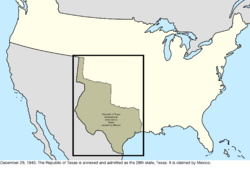
|
| June 15, 1846 | The Oregon Treaty established the 49th parallel north west of the Lake of the Woods as the continental border (so it did not include Vancouver Island) with land held by the United Kingdom. The sharing of Oregon Country ended, and the United States portion became unorganized territory.
The treaty was vague on which strait should be the border between Vancouver Island and the continent, thus causing a dispute over ownership of the San Juan Islands. It specified "through the middle of the said channel and of Fuca Straits, to the Pacific Ocean". |
 Northwestern North America:  Disputes: 
|
| September 22, 1846 | Following the capture on August 18, 1846, of Santa Fe, the capital of the Mexican territory of Santa Fe de Nuevo México, a code of laws known as the Kearny Code was created for the area. The region overlapped with Texas' claim, though Texas had little to no control over the area outside of its eastern quarter. | Unofficial change:
|
| December 28, 1846 | The southern portion of Iowa Territory, south of parallel 43°30′ north and east of the Big Sioux River, was admitted as the twenty-ninth state, Iowa. The remainder became unorganized territory. | 
|
| March 13, 1847 | The District of Columbia retroceded Alexandria County back to Virginia. Congress passed the act on July 9, 1846, residents of Alexandria County were proclaimed by the president to have agreed to it on September 7, 1846, and Virginia took possession of the land on this date. | 
|
| May 29, 1848 | The southern bulk of Wisconsin Territory, mainly east of the St. Croix River, was admitted as the thirtieth state, Wisconsin. The remainder became unorganized territory. However, the citizens of the remainder decided to continue on with a civil government, and even elected a delegate to the United States House of Representatives who would be seated on January 15, 1849, essentially making this region a de facto continuation of Wisconsin Territory. | 
|
| July 4, 1848 | The Treaty of Guadalupe Hidalgo ended the Mexican–American War and ceded a large parcel of land from Mexico, consisting of its territories of Alta California and Santa Fe de Nuevo México, and its claim to Texas. Due to a disagreement over the southern border of Santa Fe de Nuevo México, a border dispute began. |  Disputes: 
|
| August 14, 1848 | Oregon Territory was organized from the unorganized territory that was formerly part of Oregon Country. | 
|
| February 13, 1849 | The boundary dispute between Iowa and Missouri known as the Honey War was resolved by the Supreme Court of the United States. The resulting border was the Sullivan Line that existed before the dispute, roughly splitting the two claims. | 
|
| March 3, 1849 | Minnesota Territory was organized from unorganized territory east of the Missouri River and the region that had been operating as de facto Wisconsin Territory. | 
|
| March 12, 1849 | A local government formed the State of Deseret and claimed a vast portion of the southwest, including most of the Mexican Cession. Though it petitioned to be admitted to the United States, the proposal was rejected and, in 1850, Utah Territory was formed instead. The claimed area overlapped slightly with Texas' claimed area, as well as part of Oregon Territory. | Unofficial change:
|
| September 9, 1850 | The western portion of the Mexican Cession, west of the 120th meridian west, a diagonal line from where that intersects the 39th parallel north to where the Colorado River intersects the 35th parallel north, and the Colorado River, was admitted as the thirty-first state, California. The portion of the remainder north of the 37th parallel north and west of the summit of the Rocky Mountains was organized as Utah Territory. Part of Utah Territory overlapped with the portion of Texas that would be purchased on December 13, 1850, but the law authorizing the purchase was passed on this day, so the borders of Utah Territory assumed the purchase will go through. | 
|
| December 9, 1850 | The United Kingdom ceded less than one acre of underwater rock known as Horseshoe Reef in Lake Erie near Buffalo, New York for a lighthouse. It was surrounded by British waters, thus creating a form of enclave. | 
|
| December 13, 1850 | The federal government purchased the western claims of Texas. New Mexico Territory was organized from the part of this land east of the Rio Grande, along with the remaining unorganized territory from the Mexican Cession. New Mexico Territory included all of the area that had been governed under the Kearny Code. | 
|
| April 5, 1851 | The State of Deseret dissolved itself, its functions and territory largely having been superseded by Utah Territory. | Unofficial change:
|
| March 2, 1853 | Washington Territory was organized from the half of Oregon Territory north of the 46th parallel north and the Columbia River. | 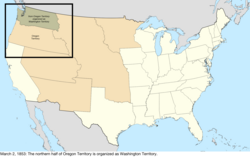
|
| May 30, 1854 | Kansas Territory was organized from unorganized territory north of the 37th parallel north, and Nebraska Territory was organized north of 40th parallel north. Much of the remaining unorganized territory, east of the 100th meridian west, became known as Indian Territory, designated as a place to resettle Indian tribes.
A small strip between the Texas Panhandle and Kansas Territory was unclaimed, due to falling south of Kansas Territory's border but north of the 36°30′ latitude established in the Missouri Compromise as the northern limit of slavery, and thus Texas could not have it. This became known as the Public Land Strip, or sometimes "No Man's Land". |

|
| June 30, 1854 | The United States purchased a large parcel from Mexico known as the Gadsden Purchase, as it offered a much better route for a southern transcontinental railroad. This resolved the border dispute, since the disputed land was included in the purchase. The purchase was defined as: starting from where the Rio Grande crosses parallel 31° 47' north; then west 100 miles; then south to parallel 31° 20' north; then west to the 111th meridian west; then a line from there to a point on the Colorado River 20 miles below the mouth of the Gila River; and the Colorado River. |  Disputes: 
|
| August 4, 1854 | The recently obtained Gadsden Purchase was assigned to New Mexico Territory. | 
|
| January 11, 1855 | Due to its remote location, Boston Corner was transferred from Massachusetts to New York. | 
|
| March 6, 1855 | The Supreme Court ruled in favor of Florida in a boundary dispute with Georgia, setting the state boundary line along McNeil's line. | no change to map |
| October 28, 1856 | Baker Island and Jarvis Island were claimed under the Guano Islands Act. | Pacific Ocean:
|
| May 11, 1858 | The half of Minnesota Territory east of the Red River of the North, the Bois de Sioux River, and a line south from the southern tip of Big Stone Lake, was admitted as the thirty-second state, Minnesota. The remainder became unorganized territory. | 
|
| August 31, 1858 | Navassa Island was claimed under the Guano Islands Act. | Caribbean Sea:
|
| December 3, 1858 | Howland Island was claimed under the Guano Islands Act. | Pacific Ocean:
|
| February 14, 1859 | The half of Oregon Territory west of the Snake River and a line south from the mouth of the Owyhee River was admitted as the thirty-third state, Oregon. The remainder was transferred to Washington Territory. | 
|
| July 6, 1859 | A team of surveyors created the "Middleton Offset," a small notch in the border between Kentucky and Tennessee. It is unknown exactly why this was done. | 
|
| September 6, 1859 | Johnston Atoll was claimed under the Guano Islands Act, though it had been claimed by Hawaii in 1858. | Pacific Ocean:
|
| November 7, 1859 | A local government was set up encompassing parts of the territories of Kansas, Nebraska, New Mexico, Utah, and Washington, with the name of Jefferson Territory, bounded by the 37th and 43rd parallels north, and 102nd and 110th meridians west. While never recognized by the federal government, it generally held control over the area until Colorado Territory was established, which adopted most of its laws. | Unofficial change:
|
| December 27, 1859 | Enderbury Island, McKean Island, Phoenix Island, and Starbuck Island were claimed under the Guano Islands Act. | Pacific Ocean:
|
| December 29, 1859 | Christmas Island and Malden Island were claimed under the Guano Islands Act. | Pacific Ocean: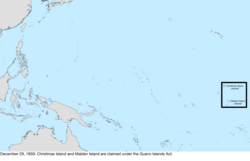
|
| February 8, 1860 | Texas created Greer County, claiming part of Indian Territory based on a different understanding from the federal government of which river was the border between the two.
Atafu, Birnie Island, Butaritari, Caroline Island, Fanning Island, Flint Island, Gardner Island, Canton Island, Kingman Reef, Manihiki, Marakei, Nukunono, Palmyra Atoll, Penrhyn, Pukapuka, Rakahanga, Swains Island, Sydney Island, Vostok Island, and Washington Island were all claimed under the Guano Islands Act. Many additional islands were listed as bonded on this date, but based on the coordinates they were either phantoms or duplicates. In addition, Sarah Ann Island was claimed, which may have existed and would be sighted as late as 1917, but has since disappeared. |
 Pacific Ocean: 
|
1860–1865 (American Civil War)
| Date | Event | Change Map |
|---|---|---|
| December 20, 1860 | In response to the election of Abraham Lincoln, South Carolina proclaimed its secession from the Union, withdrawing from the Congress of the United States. |  Disputes: 
|
| January 9, 1861 | Mississippi proclaimed its secession from the Union, withdrawing from Congress. | 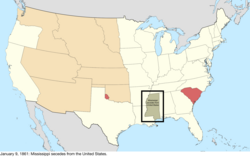 Disputes: 
|
| January 10, 1861 | Florida proclaimed its secession from the Union, withdrawing from Congress. |  Disputes: 
|
| January 11, 1861 | Alabama proclaimed its secession from the Union, withdrawing from Congress. |  Disputes: 
|
| January 19, 1861 | Georgia proclaimed its secession from the Union, withdrawing from Congress. |  Disputes: 
|
| January 26, 1861 | Louisiana proclaimed its secession from the Union, withdrawing from Congress. However, the 1st and 2nd congressional districts, around New Orleans, maintained representation in Congress. |  Disputes: 
|
| January 29, 1861 | The bulk of Kansas Territory, east of the 25th meridian west from Washington, was admitted as the thirty-fourth state, Kansas. The remainder became unorganized territory. | 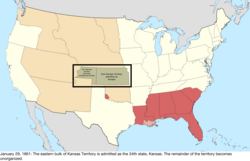
|
| February 8, 1861 | The Confederate States of America was formed by representatives of the seceded states of Alabama, Georgia, Florida, Louisiana, Mississippi, and South Carolina. | Disputes: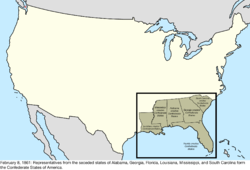
|
| February 28, 1861 | Colorado Territory was organized from portions of Nebraska Territory, New Mexico Territory, and Utah Territory, along with unorganized territory. It was bounded by the 32nd and 37th parallels north, and the 25th and 32nd meridians west from Washington. | 
|
| March 2, 1861 | Texas proclaimed its secession from the Union and was admitted to the Confederate States, withdrawing from Congress.
Dakota Territory was organized from Nebraska Territory and unorganized territory north of the Missouri, Keya Paha, and Niobrara Rivers, and 43rd parallel north. Nebraska Territory's western border was extended to the 104th meridian west, gaining small portions of Utah Territory and Washington Territory. Nevada Territory was organized from Utah Territory west of the 39th meridian west from Washington. |
 Disputes: 
|
| March 28, 1861 | Representatives in the southern half of New Mexico Territory proclaimed an independent Arizona Territory south of the 34th parallel north. | Disputes:
|
| April 12, 1861 | The Battle of Fort Sumter in South Carolina begins the American Civil War. | Disputes:
|
| April 17, 1861 | Following the Battle of Fort Sumter and President Abraham Lincoln's call for troops to respond, Virginia proclaimed its secession from the Union, withdrawing from Congress. However, the 1st (along the Eastern Shore), 7th (near Washington, D.C.), and 10th, 11th, and 12th (in the northwest of the state) congressional districts maintained representation in Congress. |  Disputes: 
|
| May 6, 1861 | Arkansas proclaimed its secession from the Union, withdrawing from Congress. |  Disputes: 
|
| May 7, 1861 | Virginia was admitted to the Confederate States. | Disputes:
|
| May 16, 1861 | Kentucky declared itself neutral in the American Civil War. | no change to map |
| May 20, 1861 | Arkansas was admitted to the Confederate States.
North Carolina proclaimed its secession from the Union, withdrawing from Congress. |
 Disputes: 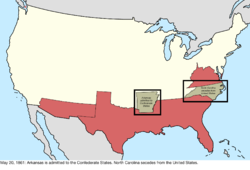
|
| May 21, 1861 | North Carolina was admitted to the Confederate States. The law admitting the state required a presidential proclamation before it was to take effect, which sources say took place on this date; the only primary source found so far is a statement from Jefferson Davis on July 20 stating that the proclamation had been made. | Disputes:
|
| June 6, 1861 | Robert Williamson Steele, governor of Jefferson Territory, declared the territory disbanded and handed over the government to the first governor of Colorado Territory. | Unofficial change:
|
| June 8, 1861 | Tennessee proclaimed its secession from the Union, withdrawing from Congress. However, the 2nd, 3rd, and 4th congressional districts in the central part of the state maintained representation in Congress. |  Disputes: 
|
| June 25, 1861 | The federal government recognized the Restored Government of Virginia in Wheeling as the legitimate government of Virginia. | 
|
| July 2, 1861 | Tennessee was admitted to the Confederate States. | Disputes: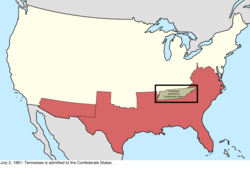
|
| August 1, 1861 | Following Confederate victory in the First Battle of Mesilla, Arizona Territory was proclaimed as part of the Confederate States. | Disputes:
|
| September 13, 1861 | Following the Confederate occupation of Columbus, Kentucky, on September 3, 1861, the state abandoned neutrality and aligned with the Union government. | no change to map |
| October 31, 1861 | A splinter government in Neosho, Missouri, declared the secession of the state from the United States. | Disputes:
|
| November 20, 1861 | A convention in Russellville, Kentucky, declared the formation of a splinter government in Bowling Green and the secession of Kentucky from the United States. | Disputes: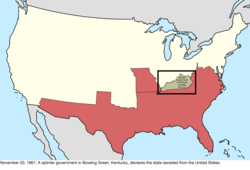
|
| November 28, 1861 | The splinter Neosho government of Missouri was admitted to the Confederate States. The Confederate States never held much power over the state, but it was given full representation in the legislature. | Disputes: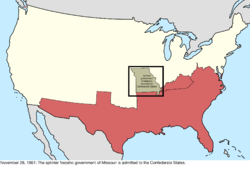
|
| December 10, 1861 | The splinter Bowling Green government of Kentucky was admitted to the Confederate States. The Confederate States never held much power over the state, but it was given full representation in the legislature. | Disputes:
|
| December 21, 1861 | The Confederate States ratified treaties with the Osage, and the Seneca and Shawnee. | Disputes:
|
| December 23, 1861 | The Confederate States ratified treaties with the Cherokee, granting them a delegate to the Congress of the Confederate States, and with the Seminole, granting them a delegate to be shared with the Creek. | Disputes:
|
| December 31, 1861 | The Confederate States ratified treaties with the Choctaw and Chickasaw, granting them a delegate in the Congress of the Confederate States; with the Comanche; with the Creek, granting them a delegate to be shared with the Seminole; and the Quapaw. | Disputes:
|
| March 1, 1862 | A decree by the Supreme Court of the United States took effect, modifying the border between Massachusetts and Rhode Island. | 
|
| April 15, 1862 | Palmyra Atoll was annexed by Hawaii, and the American claim falls dormant. | Pacific Ocean:
|
| July 14, 1862 | The western slice of Utah Territory was transferred to Nevada Territory, moving their border east to the 38th meridian west from Washington. | 
|
| December 30, 1862 | The Swan Islands were claimed under the Guano Islands Act. | Caribbean Sea:
|
| February 24, 1863 | Arizona Territory was organized from the half of New Mexico Territory west of the 32nd meridian west from Washington. | 
|
| March 3, 1863 | Idaho Territory was organized from the portions of Dakota Territory and Nebraska Territory west of the 104th meridian west, and the portion of Washington Territory east of the Snake River and a line north from the mouth of the Clearwater River. | 
|
| March 4, 1863 | Due to disruption in voting and low turnout, no one was allowed to take the seats in the United States House of Representatives held by the Unionist areas of Louisiana, Tennessee, and Virginia, effectively expelling the states. | 
|
| June 20, 1863 | The northwestern counties of Virginia, represented by the Restored Government of Virginia in Wheeling, were split from the rest of Virginia and admitted to the Union as the thirty-fifth state, West Virginia. The Restored Government of Virginia was relocated to Alexandria. | 
|
| August 5, 1863 | Berkeley County was transferred by the federal government from Virginia to West Virginia; | 
|
| November 2, 1863 | Jefferson County was transferred from Virginia to West Virginia. | 
|
| May 26, 1864 | Montana Territory was organized from the northeast third of Idaho Territory, with the border being, from the east: West along the 45th parallel north to the 34th meridian west from Washington; south to the parallel 44°30′ north; west to the crest of the Rocky Mountains; following that north to the crest of the Bitterroot Mountains; to the 39th meridian west from Washington; and north from there. The remaining portion of Idaho Territory east of the Rocky Mountains and the 33rd meridian west from Washington was transferred to Dakota Territory. | 
|
| October 15, 1864 | Malden Island was claimed by the United Kingdom. | Pacific Ocean:
|
| October 31, 1864 | Nevada Territory was admitted as the thirty-sixth state, Nevada. | 
|
| May 5, 1865 | The Confederate States cabinet met in Washington, Georgia, and dissolved. Military surrenders were scattered throughout 1865, but the most important is regarded as that of the Army of Northern Virginia following the Battle of Appomattox Court House on April 9. | Disputes:
|
1866–1897 (Reconstruction and western statehood)
| Date | Event | Change Map |
|---|---|---|
| May 5, 1866 | The western slice of Utah Territory was transferred to Nevada, moving its border east to the 37th meridian west from Washington. | 
|
| July 24, 1866 | Tennessee was readmitted to Congress. | 
|
| December 26, 1866 | Starbuck Island was claimed by the United Kingdom. | Pacific Ocean:
|
| January 18, 1867 | The northwestern corner of Arizona Territory, west of the Colorado River and the 37th meridian west from Washington, was transferred to Nevada. The law transferring the land was approved May 5, 1866, but unlike the Utah Territory transfer of that day, this transfer was contingent on the state accepting it. | 
|
| March 1, 1867 | Nebraska Territory was admitted as the thirty-seventh state, Nebraska. | 
|
| July 1, 1867 | Canada was formed from several British colonies, including New Brunswick, thus inheriting the dispute over Machias Seal Island and North Rock. | Disputes: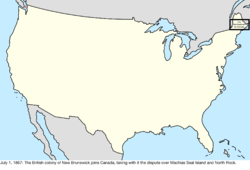
|
| August 28, 1867 | Midway Atoll was claimed. The largest island of Midway, Sand Island, had been claimed under the Guano Islands Act in 1858, but nothing more is known about this. | Pacific Ocean:
|
| October 18, 1867 | Alaska was purchased from the Russian Empire and designated the Department of Alaska. Due to a lack of quality surveying, the southeastern border with British holdings was unclear and disputed. | Northwestern North America:
|
| June 22, 1868 | Arkansas was readmitted to Congress. | 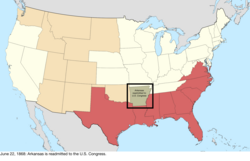
|
| June 25, 1868 | Florida was readmitted to Congress. | 
|
| July 4, 1868 | North Carolina was readmitted to Congress. | 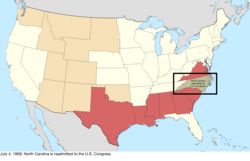
|
| July 9, 1868 | Louisiana and South Carolina were readmitted to Congress.
Caroline Island was claimed by the United Kingdom. |
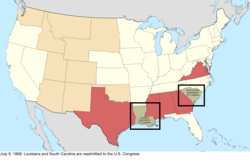 Pacific Ocean: 
|
| July 13, 1868 | Alabama was readmitted to Congress. | 
|
| July 25, 1868 | Georgia was readmitted to Congress.
Wyoming Territory was organized from portions of Dakota, Idaho, and Utah Territories, bounded by 41st and 45th parallels north, and the 27th and 34th meridians west from Washington. The territory would remain under the jurisdiction of the Dakota Territory until its own government was organized on May 19, 1869. The act organizing Wyoming Territory became law on this date, but it is unclear if the territory could be considered "organized" until May 19, 1869, as the act specifies it was not to take effect until a government is organized; however, all sources use this date as the creation, and most use it for the organization, of the territory. A tiny portion of the Dakota Territory was erroneously left behind on the western side of Wyoming Territory. |
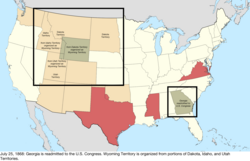
|
| August 12, 1868 | The list of bonded guano island claims mentions "Islands in Caribbean Sea not named" bonded on this date, but it is unknown what this is referring to. | no change to map |
| December 11, 1868 | Serrana Bank was claimed under the Guano Islands Act. Colombia has claimed it throughout its history. | Caribbean Sea:
|
| March 3, 1869 | Georgia was again expelled from Congress following failures of Reconstruction in the state. | 
|
| November 22, 1869 | Bajo Nuevo Bank, Pedro Cays, Quita Sueño Bank, and Roncador Bank were claimed under the Guano Islands Act. Except for Pedro Cays, Colombia has claimed them throughout its history. | Caribbean Sea:
|
| January 26, 1870 | Virginia was readmitted to Congress. | 
|
| February 23, 1870 | Mississippi was readmitted to Congress. | 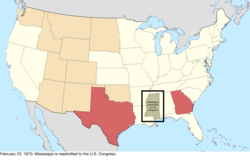
|
| March 30, 1870 | Texas was readmitted to Congress. | 
|
| July 15, 1870 | Georgia was again readmitted to Congress.
The North-Western Territory was transferred by the United Kingdom to Canada, thus transferring its portion of the Alaska boundary dispute. |
 Northwestern North America: 
|
| February 9, 1871 | A small parcel was transferred from Dakota Territory to Nebraska following a sudden change in course of the Missouri River. | 
|
| July 20, 1871 | British Columbia joined Canada, transferring the dispute over the San Juan Islands as well as its portion of the Alaska boundary dispute. | Disputes: Northwestern North America: 
|
| October 21, 1872 | The dispute with Canada over the San Juan Islands was resolved in the favor of the United States claim. | Disputes:
|
| 1873 | Vostok Island was claimed by the United Kingdom. | Pacific Ocean:
|
| February 17, 1873 | The small portion of Dakota Territory that was left behind when Wyoming Territory was created was transferred to Montana Territory. | 
|
| August 1, 1876 | Colorado Territory was admitted as the thirty-eighth state, Colorado. | 
|
| August 13, 1877 | The United Kingdom created the British Western Pacific Territories, including Atafu and Nukunono. | Pacific Ocean:
|
| March 3, 1879 | The border across the Chesapeake Bay between Maryland and Virginia was decided via arbitration. The new border cuts across Smith Island, likely meaning that the southern portion of the island was transferred to Virginia, but due to the general lack of concrete borders in the area for so long due to surveying errors, it is unknown if any land actually changed hands. | too vague to map |
| September 8, 1879 | Arenas Key, claimed by Mexico, and Serranilla Bank, claimed by Colombia, were claimed by the United States under the Guano Islands Act; according to the Office of Insular Affairs, Serranilla Bank was claimed again on September 13, 1880. | Caribbean Sea:
|
| April 7, 1880 | A very small area of Vermont near Fair Haven was transferred to New York due to a change in the course in the Poultney River. The specific area was very small and poorly documented, so it is not mapped. | too small to map |
| September 13, 1880 | Western Triangle Island, claimed by Mexico, was claimed by the United States under the Guano Islands Act. The list of bonded claims also mentions a "De Anes" island claimed on this date, with coordinates matching Isla de Aves; however, the same list points out that the claim to "Aves Island" was found to be invalid. | Caribbean Sea:
|
| 1881 | Flint Island was claimed by the United Kingdom. | Pacific Ocean:
|
| May 23, 1882 | The area between the 43rd parallel north and the Keya Paha and Niobrara Rivers was transferred from Dakota Territory to Nebraska. The act was passed in Congress on March 28 and accepted by the Nebraska legislature on this date. | 
|
| June 1, 1882 | The Morant Cays and Pedro Cays were annexed by the United Kingdom to Jamaica; it appears they were no longer claimed by the United States after this. | Caribbean Sea:
|
| May 17, 1884 | The Department of Alaska was organized into the District of Alaska. | Northwestern North America:
|
| June 21, 1884 | The Alacrans Islands, claimed by Mexico, were claimed under the Guano Islands Act. | Caribbean Sea:
|
| March 15, 1888 | Fanning Island was annexed by the United Kingdom; it appears the island was no longer claimed by the United States after this. | Pacific Ocean:
|
| March 17, 1888 | Christmas Island was claimed by the United Kingdom. | Pacific Ocean:
|
| October 26, 1888 | The Cook Islands became a protectorate of the United Kingdom, thus initiating a claim on the atolls of Pukapuka, Manihiki, Penrhyn, and Rakahanga. | Pacific Ocean:
|
| May 29, 1889 | Washington Island was annexed by the United Kingdom; it appears the island was no longer claimed by the United States after this. | Pacific Ocean:
|
| June 3, 1889 | Jarvis Island was claimed by the United Kingdom. | Pacific Ocean:
|
| June 26, 1889 | Sydney Island was claimed by the United Kingdom. | Pacific Ocean:
|
| June 29, 1889 | Phoenix Island was claimed by the United Kingdom. | Pacific Ocean: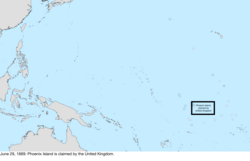
|
| July 10, 1889 | Birnie Island was claimed by the United Kingdom. | Pacific Ocean:
|
| November 2, 1889 | Dakota Territory was split in half along an east-west line a few miles south of the 46th parallel north and admitted as the thirty-ninth state, North Dakota, and the fortieth state, South Dakota. | 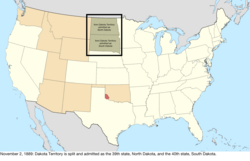
|
| November 8, 1889 | Montana Territory was admitted as the forty-first state, Montana. | 
|
| November 11, 1889 | Washington Territory was admitted as the forty-second state, Washington. | 
|
| May 2, 1890 | Oklahoma Territory was organized from the Public Land Strip and the western half of Indian Territory, except for the Cherokee Outlet, which would be added later upon cession from the Cherokee. | 
|
| July 3, 1890 | Idaho Territory was admitted as the forty-third state, Idaho. | 
|
| July 10, 1890 | Wyoming Territory was admitted as the forty-fourth state, Wyoming. | 
|
| March 8, 1892 | The Gilbert Islands became a protectorate of the United Kingdom, thus initiating a claim on Butaritari and Marakei. No record of a United States claim exists after this point, so it is assumed this is when the claim fell dormant. | Pacific Ocean:
|
| May 28, 1892 | Gardner Island was claimed by the United Kingdom. | Pacific Ocean:
|
| September 16, 1893 | Per a treaty with the Cherokee, the federal government purchased the Cherokee Outlet in the Indian Territory and opened it to settlement, transferring it to Oklahoma Territory as provided in the Oklahoma Organic Act. | 
|
| November 17, 1894 | The Alacrans Islands, Arenas Key, and Western Triangle Island were stricken from the list of claimed guano islands. | Caribbean Sea:
|
| January 4, 1896 | Utah Territory was admitted as the forty-fifth state, Utah. | 
|
| March 16, 1896 | The dispute between the federal government, on behalf of Oklahoma Territory, and Texas over Greer County was resolved in favor of the federal claim. | 
|
| July 24, 1897 | Due to an earlier shift in the course of the Missouri River, an island was transferred from Nebraska to South Dakota. | 
|
1898–1945 (Pacific and Caribbean expansion)
| Date | Event | Change Map |
|---|---|---|
| August 12, 1898 | The Republic of Hawaii was annexed. The ceremony to transfer sovereignty occurred on this date; the act was signed on July 7, 1898. Johnston Atoll was not included with Hawaii, nor was Sikaiana Atoll, which had been ceded to Hawaii in 1856 by its residents and approved by King Kamehameha IV. However, the annexation was based on the islands named in a report of the Hawaiian Commission, which omitted Sikaiana. | Pacific Ocean:
|
| January 17, 1899 | Wake Island was claimed. | Pacific Ocean: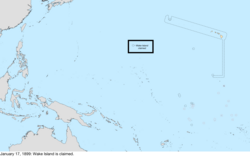
|
| April 11, 1899 | Guam, Porto Rico, and, after a payment of $20 million, the Philippines were ceded by Spain following the Spanish–American War. The Philippines were claimed by the First Philippine Republic. The ceded region for the Philippines included the island of Palmas, which was administered by the Netherlands. This overlap would not be noticed until January 21, 1906. While the United States occupied Cuba for a time, it was not ceded nor claimed. | Pacific Ocean: Caribbean Sea: 
|
| February 16, 1900 | The United States took ownership of the Samoan Islands east of the 171st meridian west, per the terms of the Tripartite Convention. | Pacific Ocean:
|
| February 19, 1900 | The newly acquired Samoan islands were established as Naval Station, Tutuila. It included all of the islands granted by the Tripartite Convention, though formal cession of the islands by local authorities would take place later in 1900 and 1904. | Pacific Ocean:
|
| April 12, 1900 | Porto Rico was organized into a civil territory. | no change to map |
| April 17, 1900 | The island of Tutuila was formally ceded to the United States and added to Naval Station, Tutuila (present-day American Samoa). As the United States had already claimed the island on February 19, 1900, no change is mapped. The treaty would be ratified by Congress on February 20, 1929. | no change to map |
| June 14, 1900 | The former Republic of Hawaii was organized into Hawaii Territory. | Pacific Ocean:
|
| March 3, 1901 | The transfer for a thin sliver of Bristol, Tennessee, to Bristol, Virginia, was approved by Congress after having been approved by both states. The location of the border along Main Street (now State Street) between the two cities was either the northern sidewalk of the street, or down the middle of the street; Tennessee's cession of the northern half of the street laid the issue to rest. | too small to map |
| March 23, 1901 | The president of the First Philippine Republic, Emilio Aguinaldo, was captured, and the republic was dissolved.
The islands of Cagayan de Sulu and Sibutu, and their associated islands, were purchased from Spain and assigned to the Philippines. The borders specified in the Treaty of Paris of 1898 had excluded these islands; the new treaty simply ceded "any and all islands belonging to the Philippine Archipelago". |
Pacific Ocean:
|
| October 20, 1903 | The Alaska boundary dispute with Canada was resolved, generally in favor of the United States claim. | Northwestern North America:
|
| December 10, 1903 | Land along southern Guantánamo Bay was leased in perpetuity from Cuba for use as a naval base; the treaty took effect February 23, 1903, and the formal handover occurred on this date. | no change to map |
| May 4, 1904 | The United States took ownership of the Panama Canal Zone. At this stage, only the most basic borders were defined; it was a zone surrounding the canal on each side for five miles, but excluded the cities of Colón and Panama City, which remained exclaves of Panama, as well as the water for their harbors. The Hay–Bunau-Varilla Treaty granting it to the United States was ratified on February 26, 1904. A formal border agreement, which also gave the Canal Zone some land and a lighthouse in northwest Colón, would be ratified on June 15, 1904. | Caribbean Sea:
|
| July 16, 1904 | The Manuʻa islands were formally ceded to the United States and added to Naval Station, Tutuila. As the United States had already claimed the islands on February 19, 1900, no change is mapped. The treaty would be ratified by Congress on February 20, 1929. | no change to map |
| December 12, 1904 | The "Taft Agreement" was made with Panama on December 3, with one of its sections refining the maritime boundary of the harbor of Panama City and the Panama Canal Zone. It became effective December 12. | no change to map |
| February 10, 1905 | The border between Arkansas and Indian Territory was slightly adjusted near Fort Smith, Arkansas, transferring a small amount of land on the east side of the Poteau River to Arkansas. | 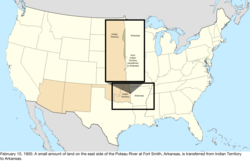
|
| November 16, 1907 | Indian Territory and Oklahoma Territory were combined and admitted as the forty-sixth state, Oklahoma. | 
|
| April 11, 1908 | A boundary treaty with the United Kingdom on behalf of Canada redefined the maritime borders between the United States and Canada. Among other changes, this "de-enclaved" Horseshoe Reef in Lake Erie by making the water around it contiguous with the water on the American side of the border. | no change to map |
| January 1, 1909 | The new Constitution of Michigan included some area of Wisconsin within its definition of Michigan. | 
|
| August 20, 1910 | A boundary treaty with the United Kingdom on behalf of Canada addressed a slight uncertainty in the maritime border in Passamaquoddy Bay between Maine and Canada. The border was adjusted to run east of Pope's Folly Island, which previously lay on the border line, and had been the subject of some debate for many years. | 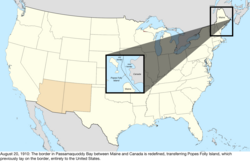
|
| July 17, 1911 | Naval Station, Tutuila, was renamed American Samoa; the station continued to operate separate from territorial governance until 1951. | Pacific Ocean:
|
| January 6, 1912 | New Mexico Territory was admitted as the forty-seventh state, New Mexico. | 
|
| February 14, 1912 | Arizona Territory was admitted as the forty-eighth state, Arizona. | 
|
| August 24, 1912 | The District of Alaska was reorganized as the Alaska Territory. | Northwestern North America:
|
| January 31, 1913 | New Mexico filed suit in the Supreme Court against Texas over the "Country Club Dispute," questioning whether the present course or the 1850 course of the Rio Grande should be their border. | 
|
| August 5, 1914 | The Corn Islands were leased from Nicaragua for a period of 99 years; however, this was not a full transfer of sovereignty, and the islands were never administered as an insular area. | no change to map |
| May 1, 1915 | The borders of the Panama Canal Zone were explicitly defined. Whereas the original definition was a simple corridor surrounding the canal, this treaty specified the actual border. Among the changes this caused were: a slice of Canal Zone was ceded to Panama so Panama City would be connected with the rest of the country; the middle island of the Las Tres Hermanas Islands, which marked the border of Panama City's harbor, was wholly made part of Canal Zone; Gatun Lake and other surrounding waters were formally annexed to the territory; and an area of northwest Colón was ceded to Canal Zone. | Caribbean Sea:
|
| May 27, 1915 | Under Article II of the 1903 Treaty, the United States expropriated from Panama several areas around the mouth of the Rio Chagres, annexing them to the Panama Canal Zone. | too small to map |
| December 8, 1915 | The United States expropriated from Panama a triangle of land, which included the historic Fort San Lorenzo, between the Rio Chagres, Caribbean Sea and the Panama Canal Zone, to which it was annexed. | too small to map |
| January 17, 1916 | Navassa Island was formally claimed for lighthouse purposes. | no change to map |
| March 31, 1917 | The Danish Virgin Islands were purchased from Denmark and renamed the United States Virgin Islands. | Caribbean Sea:
|
| July 12, 1918 | The United States expropriated from Panama 2.6 hectares of land at Punta Paitilla in Panama City and annexed it to the Panama Canal Zone. That area was enlarged to about 50 hectares within several months. | too small to map |
| August 21, 1918 | The United States expropriated from Panama land between the Rio Chagres and the Quebrada Majagual and annexed it to the Panama Canal Zone. | Caribbean Sea:
|
| September 13, 1918 | Minnesota and Wisconsin exchanged islands in the Mississippi River: Island Seventytwo was transferred from Wisconsin to the Minnesota town of Winona, and Barron's Island was transferred from Minnesota to the Wisconsin town of La Crosse. | 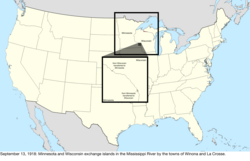
|
| September 18, 1919 | The island of Largo Remo was annexed to the Panama Canal Zone under the United States right of expropriation in the 1903 Canal Treaty. | Caribbean Sea:
|
| June 16, 1920 | Fifteen hectares on the island of Taboga Island were annexed to the Panama Canal Zone. | too small to map |
| June 30, 1921 | The "Wedge" dispute between Delaware and Pennsylvania was resolved in Delaware's favor. The disputed land had generally been administered by Delaware, even electing a member of the Delaware legislature in the mid-19th century, but federal maps had included the land as part of Pennsylvania at least as late as 1900. The states had agreed on a resolution, and it was affirmed by an act of Congress on this date. Some sources, contemporary and modern, note that, in the original process of resurveying the border in 1892, a very thin, horn-shaped region along the arc was transferred from Delaware to Pennsylvania; however, no federal maps found reflect this, and it is unclear if this transfer actually occurred. | 
|
| May 10, 1922 | Kingman Reef was formally annexed. | no change to map |
| October 8, 1923 | Michigan expanded its claim to Wisconsin territory, though Wisconsin never lost control over the area. | 
|
| November 15, 1923 | The Swan Islands were claimed by Honduras. | Caribbean Sea:
|
| February 1, 1924 | The future area for Madden Lake was annexed to the Panama Canal Zone under the United States right of expropriation in the 1903 Canal Treaty. | Caribbean Sea:
|
| March 4, 1925 | Swains Island was added to American Samoa. | Pacific Ocean:
|
| July 17, 1925 | The border with Canada was adjusted in several places. The only change to a land border redefined how the border between the Lake of the Woods and the Rocky Mountains should be considered; previously, the border followed the curve of the parallel between each border monument, while the treaty changed this to straight lines between each monument. Through this, the United States netted a gain of between 30 and 35 acres of land. Due to the extremely small shift, the lack of specific documentation of where the changes occurred, and the lack of any human impact, this change is not mapped. There was also a change to the border in the Lake of the Woods; due to inaccurate surveying, the previous border intersected itself several times in the lake, creating enclaves of United States water surrounded by Canadian water. The treaty changed the border to use the southernmost intersection as the northwestern point of the Lake of the Woods. Finally, the maritime border in the Bay of Fundy was adjusted, netting Canada roughly 9 acres of water. | too small to map |
| March 1, 1926 | The Supreme Court of the United States resolved the conflict between Michigan and Wisconsin in the favor of Wisconsin. | 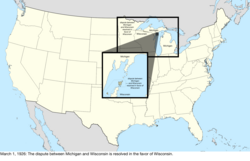
|
| July 29, 1926 | Johnston Atoll was established as a federal bird refuge and placed under the jurisdiction of the United States Department of Agriculture. The atoll had originally been claimed by both the United States and Hawaii in 1858, but little activity apart from guano mining had taken place, and it had been largely abandoned for decades. | no change to map |
| November 22, 1926 | The Supreme Court of the United States defined the border between Michigan and Wisconsin, transferring all islands south of the Quinnesec Falls on the Menominee River to Wisconsin, and all islands north of the falls to Michigan; it is unknown specifically which islands were transferred in this fashion. However, an error in the border description introduced a small overlap between the two states over several islands in Lake Michigan north of the Door Peninsula. | 
|
| July 18, 1927 | The United States expropriated from Panama another 33 hectares of land on the islands of Taboga and Taboguilla and annexed them to the Panama Canal Zone. | too small to map |
| October 26, 1927 | Two bancos along the Colorado River were ceded from Mexico to Arizona. | too small to map |
| December 5, 1927 | The "Country Club Dispute" between New Mexico and Texas was resolved in Texas's favor. | 
|
| April 4, 1928 | The Island of Palmas Case was decided in the favor of the Netherlands, ceding Palmas to the Dutch East Indies. | Pacific Ocean: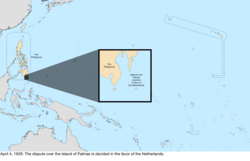
|
| September 24, 1928 | The United States expropriated from Panama three hectares of land at El Cerro de Doscientos Pies ("200-Foot Hill") near Las Minas Bay and annexed it to the Panama Canal Zone. | too small to map |
| July 22, 1930 | The United States expropriated from Panama 25 hectares on Jicarita Island and 60 hectares at Punta Morro de Puercos and annexed them to the Panama Canal Zone. | too small to map |
| April 15, 1931 | The United States expropriated from Panama additional areas around the soon-to-be-built Madden Dam and annexed them to the Panama Canal Zone. | Caribbean Sea:
|
| May 3, 1932 | The United States adjusted the border at Punta Paitilla in the Canal Zone, returning a small amount of land to Panama. This was the site for a planned new American embassy, which had to be built on foreign soil. | too small to map |
| May 17, 1932 | Porto Rico was renamed Puerto Rico. | Caribbean Sea:
|
| December 13, 1932 | The Mangsee Islands and seven of the Turtle Islands were ceded by the United Kingdom from North Borneo to the Philippines. The islands were supposed to be included in the 1900 transfer of islands from Spain to the United States. Per the terms of the treaty, the United Kingdom continued to administer the islands until requested, and after its independence, the Philippine government made such a request and took control. | Pacific Ocean: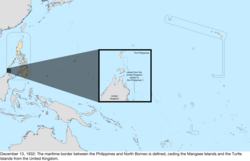
|
| May 29, 1933 | The Supreme Court of the United States ruled that the border between New Hampshire and Vermont was the low water mark of the west bank of the Connecticut River; Vermont had sought to have the border placed in the middle of the river. | no change to map |
| November 13, 1933 | A treaty created the Rio Grande Rectification Project, which, from 1935 to 1938, straightened and stabilized the path of the Rio Grande through the El Paso–Juárez Valley. By the end of the project, 174 parcels had been transferred between Mexico and Texas, each side receiving an equal area of land. | too small to map |
| December 29, 1934 | Kingman Reef was placed under the jurisdiction of the United States Department of the Navy. | no change to map |
| March 16, 1936 | The de jure overlap between Michigan and Wisconsin was resolved by the Supreme Court of the United States. | 
|
| May 13, 1936 | Baker Island, Howland Island, and Jarvis Island were formally annexed and placed under the jurisdiction of the United States Department of the Interior, ending the United Kingdom's claim to Jarvis Island. | Pacific Ocean:
|
| June 22, 1936 | The U.S. Virgin Islands were organized into a civil territory. | no change to map |
| August 6, 1936 | Canton Island, Enderbury Island, and McKean Island were claimed by the United Kingdom. | Pacific Ocean:
|
| April 6, 1939 | The condominium of the Canton and Enderbury Islands was established with the United Kingdom. | Pacific Ocean:
|
| July 27, 1939 | Panama gained a sovereign corridor that was carved out of the Panama Canal Zone connecting Colón with the rest of Panama, along with a three-dimensional "tube" of sovereignty for a future crossing over an American highway. A corridor consisting of the road from the Canal Zone boundary to Madden Dam was annexed to the Canal Zone. | Caribbean Sea:
|
| August 16, 1939 | This is the earliest date so far discovered for when the United States began claiming Fakaofo, Funafuti, Hull Island, Niulakita, Nukufetau, and Nukulaelae. | Pacific Ocean:
|
| December 10, 1941 | Governor George McMillin surrendered Guam to the Japanese military. | Pacific Ocean:
|
| December 23, 1941 | The garrison on Wake Island surrendered to the Japanese military. | Pacific Ocean:
|
| March 26, 1942 | The government of the Commonwealth of the Philippines evacuated from the territory in the face of Japanese advance. A government-in-exile would be established in Washington, D.C. on May 17, 1942. The United States Army Forces in the Far East would surrender on April 9, 1942, following the Battle of Bataan, and the final military holdouts would surrender on May 6, 1942, following the Battle of Corregidor. | Pacific Ocean:
|
| October 14, 1943 | The Second Philippine Republic was established as a puppet state of Japan. | Pacific Ocean:
|
| August 10, 1944 | Guam was captured from Japan. | Pacific Ocean:
|
| August 17, 1945 | The Second Philippine Republic, in exile in Tokyo since April 3, 1945, was dissolved. The process of re-establishing the Commonwealth government on Philippine soil had started on October 23, 1944. | Pacific Ocean: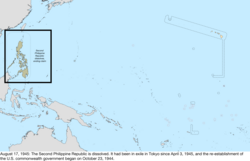
|
| September 4, 1945 | The Japanese garrison on Wake Island surrendered to the United States. | Pacific Ocean:
|
1946–Present (Decolonization)
| Date | Event | Change Map |
|---|---|---|
| July 4, 1946 | The Commonwealth of the Philippines became independent as the Republic of the Philippines. | Pacific Ocean:
|
| July 18, 1947 | The United Nations entrusted the Trust Territory of the Pacific Islands to the United States. | Pacific Ocean:
|
| January 1, 1949 | The Tokelau Islands were incorporated into New Zealand, which inherited the claims on Atafu, Fakaofo, and Nukunono. | Pacific Ocean:
|
| August 1, 1950 | Guam was organized into a civil territory. | no change to map |
| August 3, 1950 | Kansas and Missouri exchanged small portions of land along the Missouri River, due to shifts in the river following a flood in 1944. | 
|
| April 11, 1955 | Panama's corridor connecting Colón with the rest of Panama was realigned within the Panama Canal Zone. Several three-dimensional "tubes" of sovereignty were also created, allowing Panamanian bridges to pass over rivers and a highway at several locations within the Canal Zone. | too small to map |
| August 23, 1955 | Several border locations of the Panama Canal Zone were redefined. Punta Paitilla, the land held on Taboga Island, and the remaining American holdings in Colón and Panama City were ceded to Panama. | Caribbean Sea:
|
| January 3, 1959 | The Alaska Territory was admitted as the forty-ninth state, Alaska. | Northwestern North America:
|
| August 21, 1959 | Most of Hawaii Territory was admitted as the fiftieth state, Hawaii. Palmyra Atoll was excluded from statehood and remained a territory. | Pacific Ocean:
|
| August 25, 1961 | About 20 acres of land was transferred from Minnesota to North Dakota near Fargo, North Dakota; since the area was very small and poorly documented, it is not mapped. | too small to map |
| January 14, 1964 | The Chamizal, a tract of land between El Paso, Texas, and Ciudad Juárez, Chihuahua, was divided between the United States and Mexico. | 
|
| August 4, 1965 | The Cook Islands became self-governing from New Zealand. It claimed the atolls of Pukapuka, Manihiki, Penrhyn, and Rakahanga. | Pacific Ocean:
|
| December 30, 1966 | Land on Diego Garcia in the Indian Ocean was leased from the United Kingdom for use as a military base. | no change to map |
| April 25, 1971 | The lease of the Corn Islands from Nicaragua was terminated. | no change to map |
| September 1, 1972 | The United States recognized the sovereignty of Honduras over the Swan Islands. | Caribbean Sea:
|
| March 1, 1977 | The United States claimed maritime borders west of the Strait of Juan de Fuca, within the Dixon Entrance, and in the Beaufort Sea that conflicted with claims of Canada. | no change to map |
| May 26, 1977 | Several parcels were exchanged between Texas and Mexico along the Rio Grande in areas near Presidio and Hidalgo, Texas, including the Horcón Tract, on which the town of Río Rico was located, and Beaver Island near Roma, Texas. In addition, Mexico ceded 823 acres (3.33 km) to the U.S., while the U.S. ceded 2,177 acres (8.81 km) to Mexico, primarily to straighten sections of the Rio Grande for flood control. | 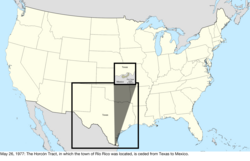
|
| December 16, 1977 | A treaty defining the maritime border with Cuba was signed; though it has never been ratified by the United States Senate, it is provisionally enforced by agreement renewed every two years. | no change to map |
| October 1, 1978 | Tuvalu became independent from the United Kingdom. It claimed the atolls of Funafuti, Nukufetau, Nukulaelae, and Niulakita. | Pacific Ocean:
|
| July 12, 1979 | The Republic of Kiribati became independent from the United Kingdom. It claimed Birnie Island, Canton Island, Caroline Island, Christmas Island, Enderbury Island, Flint Island, Gardner Island, Hull Island, Malden Island, McKean Island, Phoenix Island, Starbuck Island, Sydney Island, and Vostok Island. This dissolved the condominium of the Canton and Enderbury Islands. | Pacific Ocean:
|
| October 1, 1979 | The Panama Canal Zone was ceded to Panama. The United States and Panama continued to share operational control of the canal until December 31, 1999, when it would be fully turned over to Panama. The United States retained control over several hundred specified areas to be turned over in piecemeal fashion over the years. | Caribbean Sea:
|
| November 24, 1980 | The maritime border between the United States and Venezuela was defined. | no change to map |
| September 17, 1981 | The United States recognized the sovereignty of Colombia over Roncador Bank and Serrana Bank, and the claim on Quita Sueño Bank was abandoned by the United States, as it was no longer above the seas at high tide, and thus the government considered it unclaimable. | Caribbean Sea:
|
| September 3, 1983 | The United States recognized the sovereignty of the New Zealand territory of Tokelau over Atafu, Fakaofo, and Nukunono, and defined the maritime border with Tokelau. | Pacific Ocean:
|
| September 8, 1983 | The United States recognized the sovereignty of the Cook Islands over Pukapuka, Manihiki, Penrhyn, and Rakahanga, and the maritime border with the Cook Islands was defined. | Pacific Ocean:
|
| September 23, 1983 | The United States recognized the sovereignty of Kiribati over Birnie Island, Canton Island, Caroline Island, Christmas Island, Enderbury Island, Flint Island, Gardner Island, Hull Island, Malden Island, McKean Island, Phoenix Island, Starbuck Island, Sydney Island, and Vostok Island.
The United States recognized the sovereignty of Tuvalu over Funafuti, Nukufetau, Nukulaelae, and Niulakita. |
Pacific Ocean:
|
| October 12, 1984 | The International Court of Justice made its judgment on where the maritime border should be in the Gulf of Maine between the United States and Canada. No land changed hands. The scope of the case did not include the sovereignty of Machias Seal Island, but the judgment enabled defining the extent of the disputed water area around that island (an area of 210 square nautical miles). | no change to map |
| October 21, 1986 | The Marshall Islands District of the Trust Territory of the Pacific Islands became independent as the Republic of the Marshall Islands. The Marshall Islanders had claimed Wake Island as part of their territory since at least 1973, and continued that after independence. | Pacific Ocean:
|
| November 3, 1986 | Most of the Trust Territory of the Pacific Islands was dissolved by the United Nations. The districts of Chuuk, Pohnpei, and Yap became independent as the Federated States of Micronesia. The Mariana Islands District, having already been taking moves towards integration with the United States, became a territory of the United States, the Commonwealth of the Northern Mariana Islands. | Pacific Ocean:
|
| June 1, 1990 | The maritime border between the United States and the Soviet Union was provisionally defined. The two countries agreed on this date to abide by the terms of the treaty pending its ratification and entry into force, but while it was ratified by the United States Senate on September 16, 1991, it is unknown if either the Soviet Union or its successor state, Russia, ratified it. | no change to map |
| October 1, 1994 | The remaining district of the Trust Territory of the Pacific Islands, the Palau District, became independent as the Republic of Palau, dissolving the TTPI. | Pacific Ocean:
|
| June 1, 1995 | The maritime border between the United States and territories of the United Kingdom in the Caribbean Sea was defined. | no change to map |
| January 16, 1997 | Navassa Island was transferred to the United States Department of the Interior. | no change to map |
| November 13, 1997 | The maritime border between the United States and Mexico was defined. | no change to map |
| December 31, 1999 | All former Panama Canal Zone parcels not turned over since 1979, as well as all joint canal operations areas, were transferred to Panama. | too small to map |
| January 17, 2001 | The maritime border between the United States and Mexico on the continental shelf in the western Gulf of Mexico beyond 200 nautical miles was defined. | no change to map |
| November 24, 2009 | Six islands along the Rio Grande were ceded from Texas to Mexico, and three islands and two bancos were ceded from Mexico to Texas. The transfer, which had been pending for 20 years, was the first application of Article III of the 1970 Boundary Treaty. | too small to map |
| September 23, 2014 | The maritime border between the United States and Niue was defined. The treaty was signed on May 13, 1997, but it was not ratified by the United States until at least 2002, and the United Nations shows it as entering into force on this date. | no change to map |
| January 1, 2017 | The border between North Carolina and South Carolina was clarified following years of surveys and negotiation, moving 19 homes across state lines. | too small to map |
Bancos along the Rio Grande
Main articles: United States territorial acquisitions § Mexican boundary, and Banco Convention of 1905The Banco Convention of 1905 between the United States and Mexico allowed, in the event of sudden changes in the course of the Rio Grande (as by flooding), for the border to be altered to follow the new course. The sudden changes often created bancos, land left behind when curves in the river are cut off by rapid erosion of the channel or are intentionally cut to re-align it. When these bancos are created, the International Boundary and Water Commission investigates if land previously belonging to the United States or Mexico is to be considered on the other side of the border. In all cases of these adjustments under the 1905 convention, which occurred on 37 different dates from 1910 to 1976, the transferred land was minuscule (ranging in size from 1 acre to 646 acres) and uninhabited.
See also
- 51st state
- Geography of the United States
- Historic regions of the United States
- List of U.S. states by date of statehood
- Manifest destiny
- National Atlas of the United States
- Territorial evolution of U.S. states:
- Territorial evolution of Arizona
- Territorial evolution of California
- Territorial evolution of Colorado
- Territorial evolution of Idaho
- Territorial evolution of Montana
- Territorial evolution of Nevada
- Territorial evolution of New Mexico
- Territorial evolution of North Dakota
- Territorial evolution of Oregon
- Territorial evolution of South Dakota
- Territorial evolution of Utah
- Territorial evolution of Washington
- Territorial evolution of Wyoming
- Territories of the United States on stamps
- United States territorial acquisitions
Notes
- The borders of Connecticut were:
- For the main portion: From Long Island Sound, up the Pawcatuck River to the mouth of the Ashaway River; then a straight line to the southwest corner of the Warwick Purchase; then north to an east-west line drawn 3 miles south of the Charles River; then west to intersect the complex 1683 border with New York, which ends where the Byram River empties into Long Island Sound.
- For the western portion: A strip of land, bounded on the north by 42° 2' North (the northern border of the main portion), the south by 41° North (the southern border of the main portion), the west by the Mississippi River, and the east by the Delaware River. This claim was not seriously enforced much further west than Lake Erie, and overlapped with Pennsylvania and New York, as well as Virginia's western claim.
- The borders of Delaware were:
- The core of the border is the cupola of the court house in New Castle, around which a "Twelve-Mile Circle" was drawn. Within this circle, all land up to the far shore of the Delaware River belongs to Delaware; this has caused some land border issues with New Jersey, as any landfill into the river within the circle belongs to Delaware.
- Then down Delaware Bay to Cape Henlopen (though Fenwick Island was incorrectly used), where the "Transpeninsular Line" was drawn due west.
- From the midpoint of the Transpeninsular Line, a "Tangent Line" was drawn directly towards the western end of the Twelve-Mile Circle. This Tangent Line is the start of the Mason–Dixon line.
- The line intersects the circle slightly south of the full western end. The border then follows the western remainder, known as the "Arc Line", to a point north of where the Tangent Line met the Twelve-Mile Circle; at this point, the border turns straight north to a line drawn 15 miles south of Philadelphia, Pennsylvania, where Mason–Dixon Line then proceeds west. Delaware's border turns east towards the Twelve-Mile Circle, forming an anomaly known as "The Wedge", which was long-disputed between Delaware and Pennsylvania.
- The borders of Georgia were: From the Atlantic Ocean, up the Savannah River to where it meets 35° north; then west to the Mississippi River; then down that to the mouth of the Yazoo River; then east to the Chattahoochee River; then down that to the mouth of the Flint River; then a line to the source of St. Mary's River; then down that to the Atlantic Ocean.
- The borders of Maryland were:
- From the Atlantic Ocean at Fenwick Island (incorrectly thought to be Cape Henlopen), west along the "Transpeninsular Line" to its midpoint across the Delmarva Peninsula
- At this point, the line is known as the Mason–Dixon line: A "Tangent Line" line from there towards the western end of the "Twelve-Mile Circle" around the cupola of the courthouse in New Castle, Delaware, then following the circle around the area west of where the line intersects it (the "Arc Line"), then north from the point where it intersected, to a line 15 miles south of the Philadelphia, Pennsylvania.
- The Mason–Dixon line then proceeds west. Maryland's border follows it, then turns south at a point north of the source of the Potomac River.
- The border runs south to said source, then follows the far shore of the river until its mouth at Smith Point, where it crosses the Chesapeake Bay towards the mouth of the Pocomoke River on the Delmarva Peninsula.
- It runs up the river to 38° north, where it ideally turned east, though the resultant survey ran north of east, until it reaches the Atlantic Ocean.
- The borders of Massachusetts Bay were:
- For the main portion: From the Atlantic Ocean, following a path 3 miles east of Narragansett Bay up to the Blackstone River; up that to Pawtucket Falls; then north towards a line surveyed 3 miles south from the Charles River, though in reality parts were significantly further south; following said line west to a monument placed by Connecticut and New York during their complex border formation; north 15° 12' 9" east from there until it intersects the next line, from the east: From the Atlantic Ocean, following a path 3 miles north of the Merrimack River up to Pawtucket Falls (different from the aforementioned one), then a line west until it meets the previously mentioned line; this line too was poorly surveyed, veering significantly north over its path.
- For the northern portion, the District of Maine: From the Atlantic Ocean, up the Piscataqua River to its source; then north 2° west to the "height of the land" border with Great Britain; following that to a point north of the source of the St. Croix River; south to said source; then following the river to Passamaquoddy Bay. Which river was indeed the St. Croix River would be disputed for decades.
- For the portion overlapping with New York: bounded on the south by the New York-Pennsylvania border, the east by a line 82 miles west of where the Delaware River enters New York, and the rest by Lake Erie, the Niagara River, and Lake Ontario.
- For the western portion: A strip of land, bounded on the north by 43° 43' 12" North (the northern border of Massachusetts Bay's interpretation of their colonial charter, being 3 miles north of the source of the Merrimack River), the south by 42° 2' North (west of the southwest corner of the main portion), the west by the Mississippi River, and the east by Lake Huron, the St. Clair River, Lake St. Clair, and the Detroit River. This claim was not seriously enforced, and overlapped with Virginia's western claim.
- The borders of New Hampshire were: From the Atlantic Ocean, up the Piscataqua River to its source; then north 2 degrees west until it reaches the height of the land, the border with Great Britain; then along that towards the source of Halls Stream; then down that to 45° north; then east a tiny bit to the Connecticut River; then down that to intersect with the next line: Starting from the Atlantic Ocean, following a path 3 miles north of the Merrimack River up to Pawtucket Falls, then a line west until it meets the Connecticut River; this line too was poorly surveyed, veering significantly north over its path.
- The borders of New Jersey were: From Lower New York Bay, up Arthur Kill and Kill Van Kull to Upper New York Bay; then up the Hudson River to where it crosses 41° north; then a line to the mouth of the Neversink River, where it empties into the Delaware River; from there down to Delaware Bay, noting that Delaware owns the river up to the left bank within the "Twelve-Mile Circle", meaning there are some areas of New Jersey that border land belonging to Delaware that was added beyond the original shoreline. Despite being surrounded by New Jersey water, Bedloe's Island (now Liberty Island) and the original borders of Ellis Island were part of New York.
- The borders of New York were:
- For the main portion: From Long Island Sound, up the Byram River and following the complex 1683 border with Connecticut up to the border monument used to mark the southwest corner of Massachusetts; then north 15° 12' 9" east until it intersects the northern line of Massachusetts, ideally due east from a point 3 miles north of Pawtucket Falls on the Merrimack River but in practice surveyed significantly north; east along that line to the Connecticut River; up that to 45° north; west along that, as surveyed, to the St. Lawrence River; then up that river to Lake Ontario, the Niagara River, and Lake Erie, to 42° north; then east to the Delaware River; then down that to the mouth of the Neversink River; then a line from that to where the Hudson River intersects 41° north; then down the Hudson River to Upper New York Bay, and down Kill Van Kull and Arthur Kill to Lower New York Bay. New York included Bedloe's Island (now Liberty Island) and the original borders of Ellis Island, despite them being surrounded by New Jersey water.
- For the western portion: A large, somewhat vaguely-defined claim that ran from where the Pennsylvania border met Lake Erie, then following Lake Erie, the Detroit River, Lake St. Clair, the St. Clair River, Lake Huron, and Lake Michigan to near its southern tip; then an unknown path, probably a portage, to the Illinois River; down that to the Mississippi River to the mouth of the Tennessee River; then up that to its source; and from there an unknown path of mountain ridges back towards the Pennsylvania border.
- The borders of North Carolina were: From the mouth of the Little River on the Atlantic Ocean; northwest for some distance until where the survey stopped; then west to the Charleston Road; then to the southeast corner of Catawba lands and around their borders; then up the Catawba River to the mouth of its south fork; then west (though surveyed slightly north) to the Blue Ridge; south along that to the "Cherokee Boundary"; then from there to where the Chatooga River crosses 35° north, which was always the intended border after the northwest line from the ocean; then west to the Mississippi River; up that to 36° 30' north; then east to the Atlantic Ocean. However, the survey of 36° 30' with Virginia was incomplete, and the complete parts were far north of ideal.
- New Connecticut claimed the portion of New York east of: from the northern border with Great Britain; south through Lake Champlain and the Poultney River; then following borders of townships, which at the time were likely not surveyed.
- The New Hampshire towns petitioning to join Vermont were: Apthorp (now Littleton), Bath, Canaan, Cardigan (now Orange), Cornish, Dresden (now part of Hanover), Enfield, Franconia, New Hampshire, Gunthwaite (now Lisbon), Haverhill, Landaff, Lebanon, Lyman, Lyme, Orford, and Piermont.
- Virginia had claimed the portion of Pennsylvania south of the Ohio, Allegheny, Kiskiminetas, and Conemaugh Rivers, and west of the Laurel Ridge; Pennsylvania claimed the area "westwards 5 degrees of longitude" from its eastern borders, according to its colonial boundaries. The solution was to extend the Mason-Dixon Line, which had been run west of the western end of Maryland, to a distance of 5 degrees west from the Delaware River at that latitude. The border would then run north from there.
- The New Hampshire towns petitioning to join Vermont were: Acworth, Alstead, Bath, Cardigan (now Orange), Charlestown, Chesterfield, Claremont, Cornish, Croydon, Dorchester, Dresden, Franconia, "Gilsom" (likely Gilsum), Grafton, Grantham, Gunthwaite (now Lisbon), Hanover, Haverhill, Hinsdale, Landaff, Lancaster, Lebanon, Leinster, Lincoln, Lyman, Lyme, Marlow, Newport, Piermont, Plainfield, Richmond, Saville (now Sunapee), Surry, Walpole, and Westmoreland.
- The New York towns petitioning to join Vermont were: "Black-Creek" (unknown; possibly is or is near Hebron), Cambridge, Fort Edward, Granville, "Greenfield" (unknown; there is a town named Greenfield but it lies west of the Hudson River, which was explicitly the western extent of the West Union), Hoosick, Kingsbury, "Little Hoosack" (unknown; presumably near Hoosick), Saratoga, "Scorticook" (possibly Schaghticoke), Skeensborough (now Whitehall), and "Upper-White-Creek" (probably White Creek).
References
- ^ Van Zandt, pp. 26–27
- ^ Van Zandt, pp. 14–15
- ^ Van Zandt, pp. 151–153
- ^ Moore, John Bassett (1906). "A Digest of International Law as Embodied in Diplomatic Discussions, Treaties and Other International Agreements, International Awards, the Decisions of Municipal Courts, and the Writings of Jurists and Especially in Documents, Published and Unpublished, Issued by Presidents and Secretaries of State of the United States, the Opinions of the Attorneys-General, and the Decisions of Courts, Federal and State". Washington, DC: U.S. Government Printing Office. pp. 566–580. Archived from the original on May 1, 2016.
{{cite web}}: Unknown parameter|deadurl=ignored (|url-status=suggested) (help) - Ryden, George Herbert. The Foreign Policy of the United States in Relation to Samoa. New York: Octagon Books, 1975.
- http://www.vinow.com/general_usvi/history/ Vinow.com. Virgin Islands History. Retrieved 18 January 2018.
- ^ Exec. Order No. 11021 (July 1, 1962; in English) President of the United States. Retrieved on April 10, 2015.
- "Declaration of Independence: A Transcription". National Archives and Records Administration. Retrieved September 7, 2017.
- ^ Van Zandt, pp. 72–74
- ^ Cite error: The named reference
vz-dewas invoked but never defined (see the help page). - "Delaware Government Facts & Symbols". Government of Delaware. Archived from the original on January 9, 2017. Retrieved January 16, 2017.
{{cite web}}: Unknown parameter|deadurl=ignored (|url-status=suggested) (help) - ^ Van Zandt, pp. 100–104
- ^ Van Zandt, pp. 85–88
- ^ Van Zandt, pp. 65–71
- Cite error: The named reference
vz-nhwas invoked but never defined (see the help page). - Hampshire, New (1824). The Laws of the State of New Hampshire. pp. 239–240. Retrieved January 16, 2017.
- Cite error: The named reference
vz-njwas invoked but never defined (see the help page). - ^ Van Zandt, pp. 74–79
- Cite error: The named reference
vz-ncwas invoked but never defined (see the help page). - "Rhode Island declares independence". History Channel. Archived from the original on January 18, 2017. Retrieved January 16, 2017.
{{cite web}}: Unknown parameter|deadurl=ignored (|url-status=suggested) (help) - ^ "Nine Capitals of the United States". U.S. Senate. Archived from the original on March 20, 2016. Retrieved March 19, 2016.
{{cite web}}: Unknown parameter|deadurl=ignored (|url-status=suggested) (help) - ^ "8 Forgotten Capitals of the United States". History. Archived from the original on January 26, 2017. Retrieved March 12, 2017.
{{cite web}}: Unknown parameter|deadurl=ignored (|url-status=suggested) (help) - "The North Carolina – South Carolina Border Surveys – 1730 to 1815". Archived from the original on March 4, 2016. Retrieved December 30, 2015.
{{cite web}}: Unknown parameter|deadurl=ignored (|url-status=suggested) (help) - Kelly, Stephen R. (August 23, 2014). "How the Carolinas Fixed Their Blurred Lines". The New York Times. Archived from the original on August 31, 2014. Retrieved December 30, 2015.
{{cite news}}: Unknown parameter|deadurl=ignored (|url-status=suggested) (help) - "Constitution of Delaware". Avalon Project. Yale Law School. 1776. Archived from the original on July 9, 2009. Retrieved June 10, 2009.
{{cite web}}: Unknown parameter|deadurl=ignored (|url-status=suggested) (help) - "Constitution of Pennsylvania". Avalon Project. Yale Law School. 1776. Archived from the original on January 26, 2017. Retrieved January 16, 2017.
{{cite web}}: Unknown parameter|deadurl=ignored (|url-status=suggested) (help) - ^ Van Zandt, pp. 64–65
- Court, New Hampshire (Colony) Probate (1877). Provincial and State Papers relating to New Hampshire. pp. 242–246. Retrieved January 16, 2017.
- ^ Vermont 2006 J.R.H. 3, Joint Resolution Designating January as Vermont History and Independence Month Archived 2006-10-11 at the Wayback Machine
- ^ Vermont State Papers, pp. 89–103
- ^ "The Historical Geography of Vermont". Archived from the original on January 12, 2016. Retrieved January 24, 2016.
{{cite web}}: Unknown parameter|deadurl=ignored (|url-status=suggested) (help) - ^ "East Union". The Vermont Encyclopedia. University Press of New England. 2003. p. 111. ISBN 978-1-58465-086-7. 1584650869.
- ^ Van Zandt, pp. 80–84
- Van Zandt, p. 83
- Crumrine, Boyd (1902). "Boundary Controversy between Pennsylvania and Virginia; 1748–1785". Annals of Carnegie Museum. 1: 505–568. Retrieved August 20, 2017.
- ^ "Virginia-Tennessee Border". Archived from the original on February 6, 2016. Retrieved January 4, 2016.
{{cite web}}: Unknown parameter|deadurl=ignored (|url-status=suggested) (help) - "Articles of Confederation". The Avalon Project at Yale Law School. Archived from the original on October 29, 2015. Retrieved October 31, 2015.
{{cite web}}: Unknown parameter|deadurl=ignored (|url-status=suggested) (help) - ^ Vermont State Papers, pp. 136–137: "Agreeably to the recommendation of the committees, the Legislature of Vermont was adjourned to the first Wednesday of April ; at which time, it met at Windsor, and the union of the grants, east and west of Connecticut river, was consummated"
- ^ Vermont State Papers, pp. 138–141
- ^ "West Union". The Vermont Encyclopedia. University Press of New England. 2003. p. 319. ISBN 978-1-58465-086-7. 1584650869.
- Vermont v. New Hampshire, 289 U.S. 593 (1933)
- "Virginia's Cession of the Northwest Territory". Archived from the original on August 17, 2016. Retrieved June 21, 2016.
{{cite web}}: Unknown parameter|deadurl=ignored (|url-status=suggested) (help) - Spencer, Jesse Ames (1912). The United States: its beginnings, progress and modern development, Volume 3. Retrieved January 14, 2016.
- Gnichtel, Frederick W. (1921). "The "Pennamite Wars" and the Trenton Decree of 1782". Proceedings of the New Jersey Historical Society. 6. Retrieved November 8, 2015.
- Worthing C. Ford; et al. (eds.). Journals of the Continental Congress, 1774–1789. pp. Vol. 26, pp. 112–121.
- Van Zandt, pp. 92–95
- Treaty of Paris, 1783 Archived 2007-05-15 at the Wayback Machine; International Treaties and Related Records, 1778–1974; General Records of the United States Government, Record Group 11; National Archives.
- McGee, Gentry Richard (1911). A History of Tennessee from 1663 to 1914: For Use in Schools. pp. 95–99. Retrieved December 29, 2015.
- Williams, Samuel C. (1933). History of the Lost State of Franklin. p. 30.
- ^ Schlueter, Roger (September 8, 2016). "The state that almost was an original colony". Belleville News-Democrat. Archived from the original on September 9, 2016. Retrieved March 13, 2017.
{{cite news}}: Unknown parameter|deadurl=ignored (|url-status=suggested) (help) - Van Zandt, pp. 47–49
- Northwest Ordinance Archived March 16, 2013, at the Wayback Machine, July 13, 1787; (National Archives Microfilm Publication M332, roll 9); Miscellaneous Papers of the Continental Congress, 1774–1789; Records of the Continental and Confederation Congresses and the Constitutional Convention, 1774–1789, Record Group 360; National Archives.
- Worthington C. Ford; et al. (eds.). Journals of the Continental Congress, 1774–1789. Vol. 33. pp. 466–477.
- "Ratification of the Constitution by the State of Delaware; December 7, 1787". The Avalon Project at Yale Law School. Archived from the original on December 20, 2015. Retrieved October 31, 2015.
{{cite web}}: Unknown parameter|deadurl=ignored (|url-status=suggested) (help) - "Ratification of the Constitution by the State of Pennsylvania; December 12, 1787". The Avalon Project at Yale Law School. Archived from the original on November 5, 2015. Retrieved October 31, 2015.
{{cite web}}: Unknown parameter|deadurl=ignored (|url-status=suggested) (help) - "Ratification of the Constitution by the State of New Jersey; December 18, 1787". The Avalon Project at Yale Law School. Archived from the original on September 23, 2015. Retrieved October 31, 2015.
{{cite web}}: Unknown parameter|deadurl=ignored (|url-status=suggested) (help) - "Ratification of the Constitution by the State of Georgia; January 2, 1788". The Avalon Project at Yale Law School. Archived from the original on December 20, 2015. Retrieved October 31, 2015.
{{cite web}}: Unknown parameter|deadurl=ignored (|url-status=suggested) (help) - "Ratification of the Constitution by the State of Connecticut; January 8, 1788". The Avalon Project at Yale Law School. Archived from the original on November 7, 2015. Retrieved October 31, 2015.
{{cite web}}: Unknown parameter|deadurl=ignored (|url-status=suggested) (help) - "Ratification of the Constitution by the State of Massachusetts; February 6, 1788". The Avalon Project at Yale Law School. Archived from the original on February 9, 2016. Retrieved October 31, 2015.
{{cite web}}: Unknown parameter|deadurl=ignored (|url-status=suggested) (help) - "Ratification of the Constitution by the State of Maryland; April 28, 1788". The Avalon Project at Yale Law School. Archived from the original on July 10, 2015. Retrieved October 31, 2015.
{{cite web}}: Unknown parameter|deadurl=ignored (|url-status=suggested) (help) - "Ratification of the Constitution by the State of South Carolina; May 23, 1788". The Avalon Project at Yale Law School. Archived from the original on November 8, 2015. Retrieved October 31, 2015.
{{cite web}}: Unknown parameter|deadurl=ignored (|url-status=suggested) (help) - "Ratification of the Constitution by the State of New Hampshire; June 21, 1788". The Avalon Project at Yale Law School. Archived from the original on November 5, 2015. Retrieved October 31, 2015.
{{cite web}}: Unknown parameter|deadurl=ignored (|url-status=suggested) (help) - "Ratification of the Constitution by the State of Virginia; June 26, 1788". The Avalon Project at Yale Law School. Archived from the original on August 22, 2015. Retrieved October 31, 2015.
{{cite web}}: Unknown parameter|deadurl=ignored (|url-status=suggested) (help) - "Ratification of the Constitution by the State of New York; July 26, 1788". The Avalon Project at Yale Law School. Archived from the original on October 24, 2015. Retrieved October 31, 2015.
{{cite web}}: Unknown parameter|deadurl=ignored (|url-status=suggested) (help) - Williams, Samuel C. (1933). History of the Lost State of Franklin. p. 230.
- 1 Stat. 50
- "Ratification of the Constitution by the State of North Carolina; November 21, 1789". The Avalon Project at Yale Law School. Archived from the original on November 23, 2015. Retrieved October 31, 2015.
{{cite web}}: Unknown parameter|deadurl=ignored (|url-status=suggested) (help) - 1 Stat. 106
- ^ Van Zandt, pp. 109–111
- 1 Stat. 123
- "Ratification of the Constitution by the State of Rhode Island; May 29, 1790". The Avalon Project at Yale Law School. Archived from the original on November 22, 2015. Retrieved October 30, 2015.
{{cite web}}: Unknown parameter|deadurl=ignored (|url-status=suggested) (help) - 1 Stat. 130
- 1 Stat. 191
- 1 Stat. 130, 1 Stat. 214
- ^ Van Zandt, pp. 88–92
- Tindall, William (February 25, 1919). "Naming the Seat of Government of the United States: A Legislative Paradox". Records of the Columbia Historical Society. 23. Historical Society of Washington, D.C.: 10–25. JSTOR 40067136.
- Virginia Compacts, § 1-307. Compact and boundary with Kentucky Archived June 24, 2016, at the Wayback Machine
- 1 Stat. 189
- Van Zandt, p. 111
- Thorpe, Francis Newton (1906). The Federal and State Constitutions, Colonial Charters, and Other Organic Laws of the States, Territories, and Colonies Now or Heretofore Forming the United States of America. Government Printing Office. p. 568. ISBN 0-89941-792-2. Retrieved October 26, 2009.
- "Jay's Treaty". Library of Congress. Archived from the original on October 27, 2015. Retrieved November 2, 2015.
{{cite web}}: Unknown parameter|deadurl=ignored (|url-status=suggested) (help) - "Treaty of Friendship, Limits, and Navigation Between Spain and The United States; October 27, 1795". The Avalon Project at Yale Law School. Archived from the original on November 12, 2015. Retrieved October 30, 2015.
{{cite web}}: Unknown parameter|deadurl=ignored (|url-status=suggested) (help) - Van Zandt, p. 22
- 1 Stat. 491
- 1 Stat. 549
- ^ Van Zandt, pp. 105–106
- Van Zandt, p. 12
- 2 Stat. 56
- "Proclamation of President Adams Accepting the Political Rights over Western Reserve". Archived from the original on June 4, 2016. Retrieved October 29, 2015.
{{cite web}}: Unknown parameter|deadurl=ignored (|url-status=suggested) (help) - 2 Stat. 58
- ^ Van Zandt, pp. 114–115
- Carter II, Edward C. (1971–1972), "Benjamin Henry Latrobe and the Growth and Development of Washington, 1798–1818", Records of the Columbia Historical Society: 139
- "The Acts of Union, 1800". Archived from the original on September 23, 2015. Retrieved November 10, 2015.
{{cite web}}: Unknown parameter|deadurl=ignored (|url-status=suggested) (help) - 2 Stat. 103
- 2 Stat. 173
- Van Zandt, pp. 111–114
- Virginia v. Tennessee, 148 U.S. 503 (1893)
- ^ Van Zandt, pp. 23–26
- 2 Stat. 303
- 2 Stat. 283
- ^ Van Zandt, pp. 106–108
- 2 Stat. 309
- ^ Van Zandt, pp. 127–128
- 2 Stat. 331
- 2 Stat. 514
- ^ Van Zandt, pp. 116–117
- Higgs, Robert. ""Not Merely Perfidious but Ungrateful": The U.S. Takeover of West Florida". Independent Institute. Archived from the original on May 23, 2016. Retrieved June 14, 2016.
{{cite web}}: Unknown parameter|deadurl=ignored (|url-status=suggested) (help) - "Proclamation—Occupation of West Florida (October 27, 1810)". Miller Center of Public Affairs. Archived from the original on October 30, 2015. Retrieved October 29, 2015.
{{cite web}}: Unknown parameter|deadurl=ignored (|url-status=suggested) (help) - Cox, Isaac Joslin (1918). The West Florida Controversy, 1798–1813 – a Study in American Diplomacy. Baltimore, Maryland: The Johns Hopkins Press.
- 2 Stat. 701
- 2 Stat. 734
- 2 Stat. 743
- ^ Van Zandt, pp. 117–118
- 2 Stat. 708
- Louisiana; Lislet, Louis Moreau (1828). A General Digest of the Acts of the Legislature of Louisiana: Passed from the Year 1804, to 1827, Inclusive. p. 9. Retrieved October 28, 2015.
- ^ "Detroit surrenders without a fight". The History Channel. Archived from the original on May 19, 2016. Retrieved June 13, 2016.
{{cite web}}: Unknown parameter|deadurl=ignored (|url-status=suggested) (help) - Farmer, Silas (1884), The History of Detroit and Michigan: Or, the Metropolis Illustrated, Detroit: S. Farmer, p. 224, OCLC 359750
- "Town History". Town of Brookville, Maryland. Archived from the original on May 5, 2016. Retrieved June 13, 2016.
{{cite web}}: Unknown parameter|deadurl=ignored (|url-status=suggested) (help) - 3 Stat. 289, 3 Stat. 399
- 3 Stat. 371
- ^ Van Zandt, pp. 108–109
- 3 Stat. 348, 3 Stat. 472
- Alabama Terr. Acts 1818, 1st session, pp. 17–18 Archived March 4, 2016, at the Wayback Machine
- Burrage, Henry Sweetser (1919). Maine in the Northeastern Boundary Controversy. p. 78. Retrieved June 22, 2016.
- 3 Stat. 428, 3 Stat. 536
- 8 Stat. 248
- "Treaties in Force" (PDF). United States Department of State. Archived from the original (PDF) on May 7, 2015. Retrieved July 14, 2015.
{{cite web}}: Unknown parameter|deadurl=ignored (|url-status=suggested) (help) - 3 Stat. 493
- ^ Van Zandt, pp. 118–120
- 3 Stat. 489, 3 Stat. 608
- 3 Stat. 544
- Van Zandt, pp. 55–60
- 3 Stat. 565
- ^ Van Zandt, p. 165
- Rowland, Dunbar (1917). The Official and Statistical Register of the State of Mississippi, Volume 4. pp. 57–58. Retrieved November 23, 2015.
- Alabama Acts 1820, 2nd session, p. 92
- ^ "The United States Formally Takes Control of Florida (July 17, 1821)". State Library and Archives of Florida. Archived from the original on September 8, 2015. Retrieved July 14, 2015.
{{cite web}}: Unknown parameter|deadurl=ignored (|url-status=suggested) (help) - 3 Stat. 545
- 3 Stat. 654
- ^ Van Zandt, pp. 104–105
- 4 Stat. 40
- "Convention Between the United States of America and His Majesty the Emperor of All the Russias, Relative to Navigating, Fishing, Etc., in the Pacific Ocean". Archived from the original on March 19, 2016. Retrieved January 3, 2016.
{{cite web}}: Unknown parameter|deadurl=ignored (|url-status=suggested) (help) - 7 Stat. 311
- Van Zandt, pp. 15-17
- ^ Keedy, Edwin R. (January 1953). "The Constitutions of the State of Franklin, the Indian Stream Republic and the State of Deseret". University of Pennsylvania Law Review. 101 (4). University of Pennsylvania Law Review: 521–525. JSTOR 3309935.
- 4 Stat. 701
- Foreign Office, Great Britain (1852). British and Foreign State Papers. p. 444. Retrieved June 28, 2016.
- 5 Stat. 50
- 5 Stat. 10
- ^ Van Zandt, pp. 128–131
- "The Frostbitten Convention; or, How Michigan Ended the Toledo War and Became a State". Archived from the original on August 9, 2016. Retrieved June 22, 2016.
{{cite web}}: Unknown parameter|deadurl=ignored (|url-status=suggested) (help) - 5 Stat. 144
- 5 Stat. 34, 5 Stat. 802
- 5 Stat. 235
- ^ Van Zandt, pp. 131–133
- PA50#v=onepage&q&f=false An ACT defining the northern boundary line of this State Archived May 9, 2016, at the Wayback Machine, accessed July 12, 2015
- 5 Stat. 674
- "Text of "The Webster–Ashburton Treaty"". The Avalon Project at Yale Law School. Archived from the original on 2006-08-25. Retrieved 2006-08-04.
{{cite web}}: Unknown parameter|deadurl=ignored (|url-status=suggested) (help) - Van Zandt, pp. 17–18
- "Evolution of Michigan's Boundaries: The Minnesota Sliver". Michigan State University. Archived from the original on January 8, 2016. Retrieved December 27, 2015.
{{cite web}}: Unknown parameter|deadurl=ignored (|url-status=suggested) (help) - Text from Webster–Ashburton Treaty: "till the line thus run intersects the old line of boundary surveyed and marked by Valentine and Collins previously to the year 1774, as the 45th degree of north latitude, and which has been known and understood to be the line of actual division between the States of New York and Vermont on one side, and the British Province of Canada on the other"
- "Provisional and Territorial Records Guide – 1843 Map". Oregon State Archives. Archived from the original on December 31, 2015. Retrieved March 12, 2016.
{{cite web}}: Unknown parameter|deadurl=ignored (|url-status=suggested) (help) - 5 Stat. 742
- 9 Stat. 108
- Van Zandt, pp. 120–127
- ^ "A Guide to the United States' History of Recognition, Diplomatic, and Consular Relations, by Country, since 1776: Texas". United States State Department. Archived from the original on April 1, 2017. Retrieved April 3, 2017.
{{cite web}}: Unknown parameter|deadurl=ignored (|url-status=suggested) (help) - "Text of "Treaty with Great Britain, in Regard to Limits Westward of the Rocky Mountains"". The Avalon Project at Yale Law School. Archived from the original on 2009-04-19. Retrieved 2006-08-04.
{{cite web}}: Unknown parameter|deadurl=ignored (|url-status=suggested) (help) - ^ Van Zandt, p. 18
- Lavash, Donald (2006). A Journey Through New Mexico History. p. 129. ISBN 978-0-86534-541-6. Retrieved March 16, 2016.
- "New Mexico – Laws for the Government of the Territory of New Mexico; September 22, 1846". The Avalon Project at Yale Law School. Archived from the original on April 1, 2016. Retrieved March 16, 2016.
{{cite web}}: Unknown parameter|deadurl=ignored (|url-status=suggested) (help) - "(James S. Calhoun's Annotated Copy) Map of the Territory of New Mexico Made by Order of Brig. Gen. S.W. Kearny under Instructions from Lieut. W.H. Emory, U.S.T.E. by Lieut's J.W. Abert and W.G. Peck, U.S.T.E., 1846–7". 1850. Archived from the original on August 18, 2016. Retrieved March 16, 2016.
{{cite web}}: Unknown parameter|deadurl=ignored (|url-status=suggested) (help) - 9 Stat. 117
- 9 Stat. 35
- 9 Stat. 1000
- An ACT to extend the jurisdiction of the commonwealth of Virginia over the county of Alexandria Archived May 10, 2016, at the Wayback Machine
- 9 Stat. 233
- Williams, J. Fletcher. Henry Hastings Sibley: A Memoir. Minnesota Historical Society. pp. 277–281. Archived from the original on March 7, 2016. Retrieved December 28, 2015.
{{cite book}}: Unknown parameter|deadurl=ignored (|url-status=suggested) (help) - 9 Stat. 922
- ^ Van Zandt, pp. 28–29
- 9 Stat. 323
- ^ Van Zandt, pp. 153–155
- Missouri v. Iowa, 48 U.S. 660 (1849)
- 9 Stat. 403
- ^ Van Zandt, pp. 133–134
- Danver, Steven L (April 25, 2013). "Young, Brigham". Encyclopedia of Politics of the American West. p. 675. ISBN 978-1-4522-7606-9. Retrieved January 28, 2016.
- 9 Stat. 452
- 9 Stat. 453
- ^ Van Zandt, pp. 159–160
- ^ Treaty between the United States of America and the United Kingdom Concerning the Boundary between the United States and the Dominion of Canada from the Atlantic Ocean to the Pacific Ocean, signed April 11, 1908; accessed June 30, 2015
- 9 Stat. 446
- ^ Van Zandt, pp. 160–165
- Deseret (1919). Laws and ordinances of the state of Deseret (Utah). p. Prefatory. Retrieved June 22, 2016.
- 10 Stat. 172
- ^ Van Zandt, pp. 155–156
- 10 Stat. 277
- ^ Van Zandt, pp. 138–139
- ^ Van Zandt, pp. 136–138
- Kenneth R. Turner, "No Man's Land," Archived April 2, 2015, at the Wayback Machine Encyclopedia of Oklahoma History and Culture, www.okhistory.org (accessed June 04, 2015).
- "Gadsden Purchase Treaty : December 30, 1853". The Avalon Project at Yale Law School. Archived from the original on May 19, 2015. Retrieved June 3, 2015.
{{cite web}}: Unknown parameter|deadurl=ignored (|url-status=suggested) (help) - 10 Stat. 575
- 10 Stat. 602
- Van Zandt, p. 70
- Report of the Regents of the University on the Boundaries of the State of New York, Volume II. 1884. pp. 219–223. Retrieved July 9, 2015.
- Florida v. Georgia, 58 U.S. 478, 480 (US 1854).
- 11 Stat. 285
- 11 Stat. 383
- Kleber, John E. "Middleton Offset". The Kentucky Encyclopedia. p. 635. ISBN 0-8131-2883-8. Retrieved October 28, 2015.
- "Tennessee-Kentucky border didn't turn out as straight as it was supposed to be" (PDF). Archived from the original (PDF) on March 4, 2016. Retrieved October 28, 2015.
{{cite web}}: Unknown parameter|deadurl=ignored (|url-status=suggested) (help) - ^ "Departmental Manual". U.S. Department of the Interior Office of Insular Affairs. Retrieved July 15, 2016.
- ^ JSTOR 1832884
- ^ 162 U.S. 1 (1896)
- "Vanishing of Sarah Ann, Tiny Pacific Island, Causes Scientists Much Worry". Washington: Lundington Daily News. October 16, 1932. p. 1. Retrieved 13 January 2010.
- ^ "Secession Ordinances of 13 Confederate States". University of Houston. Archived from the original on September 5, 2015. Retrieved May 24, 2015.
{{cite web}}: Unknown parameter|deadurl=ignored (|url-status=suggested) (help) - 12 Stat. 126
- Constitution for the Provisional Government of the Confederate States of America Archived August 20, 2016, at the Wayback Machine, accessed July 8, 2015
- 12 Stat. 172
- ^ Van Zandt, pp. 141–144
- An Act to admit Texas as a member of the Confederate States of America Archived August 20, 2016, at the Wayback Machine, accessed July 8, 2015
- 12 Stat. 239
- ^ Van Zandt, pp. 134–136
- 12 Stat. 209
- ^ Van Zandt, pp. 158–159
- "Arizona Territory". National Park Service. Archived from the original on April 6, 2017. Retrieved April 5, 2017.
{{cite web}}: Unknown parameter|deadurl=ignored (|url-status=suggested) (help) - An Act to admit the Commonwealth of Virginia as a member of the Confederate States of America Archived August 20, 2016, at the Wayback Machine, accessed July 8, 2015
- An Act to admit the State of Arkansas into the Confederacy Archived August 20, 2016, at the Wayback Machine, accessed July 8, 2015
- An Act to admit the State of North Carolina into the Confederacy, on a certain condition Archived August 20, 2016, at the Wayback Machine, accessed June 29, 2016
- "Secession". John Locke Foundation.
- Confederate Congress 1861, 1:272. (View the page cited)
- "VIRGINIA.; The Restored Government of Virginia—History of the New State of Things". The New York Times. June 26, 1864. Archived from the original on August 12, 2016.
{{cite news}}: Unknown parameter|deadurl=ignored (|url-status=suggested) (help) - Navy Dept, United States; Rush, Richard (1922). Official Records of the Union and Confederate Navies in the War of the Rebellion. p. 103. Retrieved June 22, 2016.
- Colton, Ray Charles (1985). The Civil War in the Western Territories. University of Oklahoma Press. pp. 122–123. ISBN 0-8061-1902-0. Retrieved August 3, 2010.
- KY Acts 1861 p. 110 Archived December 21, 2016, at the Wayback Machine
- Confederate Public Law Session V, Chapter I; accessed May 22, 2015
- Confederate Public Law Session V, Chapter V Archived April 21, 2016, at the Wayback Machine; accessed May 22, 2015
- ^ "As long as grass shall grow and water run: The treaties formed by the Confederate States of America and the tribes in Indian Territory, 1861". University of Nebraska–Lincoln. Archived from the original on October 24, 2016. Retrieved May 2, 2017.
{{cite web}}: Unknown parameter|deadurl=ignored (|url-status=suggested) (help) - ^ "Maps and History of Oklahoma County 1830–1900". Archived from the original on April 14, 2017. Retrieved May 2, 2017.
{{cite web}}: Unknown parameter|deadurl=ignored (|url-status=suggested) (help) - 11 Stat. 382
- ^ "Palmyra Atoll". Office of Insular Affairs. Archived from the original on September 10, 2015. Retrieved July 8, 2015.
{{cite web}}: Unknown parameter|deadurl=ignored (|url-status=suggested) (help) - 12 Stat. 575
- 12 Stat. 664
- 12 Stat. 808
- ^ Van Zandt, pp. 156–158
- Martis, Kenneth C., "Historical Atlas of Political Parties in the United States Congress: 1789-1989, 1989 ISBN 0-02-920170-5 p. 116.
- 13 Stat. 731
- Van Zandt, pp. 95–96
- W.Va. Acts 1863, 1st sess., ch. 35, sec. 1/pp. 33–35 Archived April 6, 2016, at the Wayback Machine
- W.Va. Acts 1863, 1st sess., ch. 90, sec. 1/pp. 103–105 Archived May 22, 2016, at the Wayback Machine
- ^ Van Zandt, pp. 145–151
- 13 Stat. 85
- ^ "Chronology". Historical Dictionary of the British Empire. London: Rowman & Littlefield. 2015. pp. xix–xxxviii. ISBN 978-0-8108-7524-1. Archived from the original on April 8, 2016. Retrieved July 4, 2015.
{{cite encyclopedia}}: Unknown parameter|deadurl=ignored (|url-status=suggested) (help) - 13 Stat. 749
- "Remaining Confederate Cabinet Dissolves". Kansas City Public Library. Archived from the original on March 3, 2016. Retrieved May 21, 2015.
{{cite web}}: Unknown parameter|deadurl=ignored (|url-status=suggested) (help) - ^ 14 Stat. 43
- 14 Stat. 364
- Society, Nevada State Historical (1909). First Biennial Report of the Nevada Historical Society. p. 133. Archived from the original on April 18, 2016. Retrieved May 21, 2015.
{{cite book}}: Unknown parameter|deadurl=ignored (|url-status=suggested) (help) - 14 Stat. 820
- ^ "Acquisition Process of Insular Areas". United States Department of the Interior Office of Insular Affairs. Archived from the original on August 15, 2016. Retrieved July 15, 2016.
{{cite web}}: Unknown parameter|deadurl=ignored (|url-status=suggested) (help) - Austin, Erik W.; Clubb, Jerome M. (1986). Political Facts of the United States Since 1789. Columbia University Press. p. 76. ISBN 978-0-231-06094-3. Archived from the original on May 27, 2016. Retrieved July 6, 2015.
{{cite book}}: Unknown parameter|deadurl=ignored (|url-status=suggested) (help) - "Treaty concerning the Cession of the Russian Possessions in North America by his Majesty the Emperor of all the Russias to the United States of America". The Avalon Project at Yale Law School. Archived from the original on 2009-01-29. Retrieved 2006-08-04.
{{cite web}}: Unknown parameter|deadurl=ignored (|url-status=suggested) (help) - ^ Van Zandt, p. 32
- 15 Stat. 72
- Act authorizing readmission on ratification of 14th amendment: 15 Stat. 73. Florida ratified the amendment before that law was passed, so Florida was readmitted upon passage of the law.
- Act authorizing readmission on ratification of 14th amendment: 15 Stat. 73. Proclamation of North Carolina's ratification: 15 Stat. 703.
- Act authorizing readmission on ratification of 14th amendment: 15 Stat. 73. Proclamations of Louisiana's and South Carolina's ratification: 15 Stat. 704.
- Act authorizing readmission on ratification of 14th amendment: 15 Stat. 73. Proclamation of Alabama's ratification: 15 Stat. 704.
- Meyers, Christopher C. (2008). The Empire State of the South. ISBN 978-0-88146-111-4. Archived from the original on May 21, 2016. Retrieved May 19, 2015.
{{cite book}}: Unknown parameter|deadurl=ignored (|url-status=suggested) (help) - 15 Stat. 178
- ^ Van Zandt, pp. 144–145
- "Wyoming History". State of Wyoming. Archived from the original on November 8, 2015. Retrieved November 12, 2015.
{{cite web}}: Unknown parameter|deadurl=ignored (|url-status=suggested) (help) - ^ Van Zandt, pp. 136, 149–150
- Chisholm, Hugh (1910). "Georgia". Encyclopædia Britannica. p. 757. Retrieved July 6, 2015.
- 16 Stat. 62
- 16 Stat. 67
- 16 Stat. 80
- 16 Stat. 363
- "Northwest Territories". The Canadian Encyclopedia. Archived from the original on June 27, 2015. Retrieved July 6, 2015.
{{cite web}}: Unknown parameter|deadurl=ignored (|url-status=suggested) (help) - 16 Stat. 93
- "British Columbia". The Canadian Encyclopedia. Archived from the original on June 20, 2015. Retrieved July 6, 2015.
{{cite web}}: Unknown parameter|deadurl=ignored (|url-status=suggested) (help) - "Vostok Island". Historical Dictionary of the British Empire. London: Rowman & Littlefield. 2015. pp. 561–562. ISBN 978-0-8108-7524-1. Archived from the original on May 16, 2016. Retrieved July 2, 2015.
{{cite encyclopedia}}: Unknown parameter|deadurl=ignored (|url-status=suggested) (help) - 17 Stat. 464
- 18 Stat. 474
- "Union Islands". Historical Dictionary of the British Empire. London: Rowman & Littlefield. 2015. pp. 540–541. ISBN 978-0-8108-7524-1. Archived from the original on May 6, 2016. Retrieved July 2, 2015.
{{cite encyclopedia}}: Unknown parameter|deadurl=ignored (|url-status=suggested) (help) - 21 Stat. 72
- "Flint Island". Historical Dictionary of the British Empire. London: Rowman & Littlefield. 2015. p. 191. ISBN 978-0-8108-7524-1. Archived from the original on May 12, 2016. Retrieved July 2, 2015.
{{cite encyclopedia}}: Unknown parameter|deadurl=ignored (|url-status=suggested) (help) - 22 Stat. 35
- Watkins, Albert (1913). "Nebraska Territorial Acquisition". Collections of the Nebraska State Historical Society. XVII. Nebraska State Historical Society: 53. Retrieved May 18, 2015.
- Letters Patent ... for the Annexation of Morant and Pedro Cays to the Island of Jamaica Archived April 17, 2016, at the Wayback Machine
- 23 Stat. 24
- ^ "Unknown title". United Empire. 4. Royal Colonial Institute: 266. 1914. Retrieved June 22, 2015.
- ^ 25 Stat. 676
- 26 Stat. 81
- ^ Van Zandt, pp. 139–140
- 26 Stat. 215
- 26 Stat. 222
- 27 Stat. 640
- 28 Stat. 107
- 30 Stat. 214
- "Hawaii". Office of the Historian, Bureau of Public Affairs, United States Department of State. Archived from the original on June 19, 2015. Retrieved May 14, 2015.
{{cite web}}: Unknown parameter|deadurl=ignored (|url-status=suggested) (help) - 30 Stat. 750
- "U.S. Insular Areas: Application of the U.S. Constitution" Archived 2008-02-16 at the Wayback Machine (pdf). Report to the Chairman, Committee on Resources, House of Representatives. United States General Accounting Office. November 1997. Page 39, footnote 2.
- Report of the Hawaiian Commission, S. Doc. No. 16, 55th Cong., at 4 (3d Sess. 1898)
- "Wake Island Occupation" (PDF). The New York Times. March 21, 1899. Retrieved May 14, 2015.
- "Treaty of Peace Between the United States and Spain; December 10, 1898". The Avalon Project at Yale Law School. Archived from the original on May 23, 2015. Retrieved May 14, 2015.
{{cite web}}: Unknown parameter|deadurl=ignored (|url-status=suggested) (help) - ^ Island of Palmas Case (Netherlands, USA) Archived October 3, 2016, at the Wayback Machine, April 4, 1928; accessed June 2, 2015
- ^ "Treaties, Cessions, and Federal Laws". American Samoa Bar Association. Archived from the original on March 4, 2016. Retrieved May 11, 2015.
{{cite web}}: Unknown parameter|deadurl=ignored (|url-status=suggested) (help) - 31 Stat. 77
- https://americansamoa.noaa.gov/about/history.html National Marine Sanctuary of American Samoa. History. americansamoa.noaa.gov. Retrieved 18 January 2018.
- 31 Stat. 141
- 31 Stat. 1465
- Va. Code Ann. § 1-306, Virginia Compacts – Boundary with Tennessee Archived June 24, 2016, at the Wayback Machine
- Map of the borders of the Treaty of Paris (1898)
- 31 Stat. 1942
- "Agreement Between the United States and Cuba for the Lease of Lands for Coaling and Naval stations; February 23, 1903". The Avalon Project at Yale Law School. Archived from the original on June 4, 2016. Retrieved June 13, 2016.
{{cite web}}: Unknown parameter|deadurl=ignored (|url-status=suggested) (help) - Kramer, Paul (July 30, 2013). "A Useful Corner of the World: Guantánamo". The New Yorker. Retrieved June 4, 2018.
- DuVal, Miles P. (1947). And the Mountains Will Move: The Story of the Building of the Panama Canal. Stanford University Press. ISBN 978-0-8047-1151-7. Archived from the original on April 24, 2016. Retrieved May 12, 2015.
{{cite book}}: Unknown parameter|deadurl=ignored (|url-status=suggested) (help) - 33 Stat. 2234
- Canal Zone Boundaries Archived April 28, 2016, at the Wayback Machine; signed June 15, 1904; accessed June 30, 2015
- ^ Van Zandt, pp. 58–60
- Committee On Appropriations, United States. Congress. House; Tawney, James A (1908). Hearings concerning estimates for construction of the Isthmian Canal for the fiscal year 1909. Retrieved July 6, 2015.
- H.R. Doc. No. 458 part 10, 58th Cong., 2nd Sess. (1904), pp. 936–941 (Specifically for this citation, sec. 5 on page 938)
- 33 Stat. 714
- Myers, Arther J.; Vosburg, David L. (November 1964). "Distances Within the State of Oklahoma" (PDF). Oklahoma Geology Notes. 24 (11). University of Oklahoma: 256. Archived from the original (PDF) on March 4, 2016. Retrieved May 17, 2015.
{{cite journal}}: Unknown parameter|deadurl=ignored (|url-status=suggested) (help) - 35 Stat. 2160
- Van Zandt, pp. 18–20
- International Boundary between the United States and the Dominion of Canada through the St. Lawrence River and Great Lakes, Sheet No. 12 – Niagara River (Map). Buffalo, New York: International Waterways Commission. August 15, 1913. Archived from the original on March 4, 2016. Retrieved August 8, 2016.
{{cite map}}: Unknown parameter|deadurl=ignored (|url-status=suggested) (help) - ^ Wisconsin v. Michigan, 270 U.S. 295 (1926)
- 36 Stat. 2477
- Van Zandt, p. 20
- ^ "Maritime Boundaries". United States Department of State. Retrieved August 19, 2018.
- "Who Owns Pope's Folly Island?". The New York Times. June 20, 1893. Archived from the original on March 5, 2016. Retrieved May 11, 2015.
{{cite news}}: Unknown parameter|deadurl=ignored (|url-status=suggested) (help) - Link to a download for the United States Geological Survey map of the Eastport Quadrangle from 1907:
- "Manu'a celebrates 105 years under the U.S. Flag". Samoa News. July 16, 2009. Archived from the original on September 27, 2011. Retrieved May 11, 2015.
{{cite news}}: Unknown parameter|deadurl=ignored (|url-status=suggested) (help) - 37 Stat. 39
- 37 Stat. 1728
- 37 Stat. 512
- Bowden, J.J. (October 1959). "The Texas-New Mexico Boundary Dispute Along the Rio Grande". Southwestern Historical Quarterly. 63 (2). Texas State Historical Association: 221–237. Retrieved May 11, 2015.
- ^ "Formerly Disputed Islands". U.S. Department of the Interior Office of Insular Affairs. Archived from the original on March 5, 2016. Retrieved June 13, 2016.
{{cite web}}: Unknown parameter|deadurl=ignored (|url-status=suggested) (help) - 38 Stat. 1893
- Canal Zone Boundaries Archived May 16, 2016, at the Wayback Machine, signed September 2, 1914; U.S. Treaty Series 610; accessed June 30, 2015
- "Boundary Convention". The Canal Record. Balboa Heights, Panama. June 9, 1915. Archived from the original on August 27, 2016. Retrieved June 30, 2015.
{{cite news}}: Unknown parameter|deadurl=ignored (|url-status=suggested) (help) - ^ McCain, William D. (1965). The United States and the Republic of Panama (2nd printing). New York: Russell & Russell. pp. 144–159.
- 39 Stat. 1763
- 39 Stat. 1706
- Van Zandt, pp. 39–40
- "Letter, Chester Harding (Governor of the Panama Canal Zone) to Luis Urriola (President of the Republic of Panama), July 12, 1918". Memoria que presenta el Secretario de Relaciones Exteriores a la Honorable Asamblea Nacional en sus Sesiones Ordinarias de 1918. Panama: Republic of Panama: 303–305. 1919.
- "The Panama Canal Record". Vol. XIII, no. 39. Balboa Heights, Canal Zone: The Panama Canal. May 12, 1920. pp. 584–585.
... it was not until the year 1918, when the Governor of the Canal Zone addressed a communication to the Secretary of Foreign Affairs of the Republic of Panama stating that the United States Government would require 50.6 hectares, that the exact area expropriated was definitely known.
- Canal Zone. Office of the Governor. (1919). Annual Report of the Governor of the Panama Canal for the Fiscal Year ended June 30, 1919. Washington, DC: U.S. Government Printing Office. p. 94. Archived from the original on May 6, 2016.
A survey was made and a map drawn up showing the boundary lines of the Punta Paitilla military reservation. Various areas were determined with reference to high and low water and the old and new city boundary lines. Permanent monuments were set and a description written up by metes and bounds. A tracing was made of the map of the military reservation known as area 'A'.
{{cite book}}: Unknown parameter|deadurl=ignored (|url-status=suggested) (help) - ^ Panama Canal Zone and Vicinity Showing Judicial Districts (Map). National Archives, College Park, Maryland: United States Army. 1927. Archived from the original on October 11, 2016.
{{cite map}}: Unknown parameter|deadurl=ignored (|url-status=suggested) (help) (with hand-drawn features dated 1932) - 40 Stat. 959
- U.S. For. Rel., 1920, III, 314–322; Specifically, page 315, D-No. 60
- U.S. For. Rel., 1920, III, 314–322; Specifically, page 322, S.P.-No. 1362
- ^ Ecenbarger, Bill (August 30, 2001). Walkin' the Line: A Journey from Past to Present Along the Mason-Dixon. M. Evans and Company, Inc. pp. 89–91. ISBN 978-1-4617-1076-9. Archived from the original on April 23, 2016. Retrieved May 10, 2015.
{{cite book}}: Unknown parameter|deadurl=ignored (|url-status=suggested) (help) - Link to a download for the United States Geological Survey map of the Elkton Quadrangle from August 1900: . Note that later reprints of the same map, as early as 1906, changed ownership of the Wedge to Delaware:
- "Pub.Res. 7". 1921. Archived from the original on April 9, 2016.
{{cite web}}: Unknown parameter|deadurl=ignored (|url-status=suggested) (help) - ^ Hayes, J. Carroll (July 1923). "The Delaware Curve: The Story of the Pennsylvania-Delaware Circular Boundary". Pennsylvania Magazine of History and Biography. 47 (3). Historical Society of Pennsylvania. Retrieved May 10, 2015.
- "Refuse to be Expatriated: Citizens of Delaware Decline to Become Pennsylvanians". The New York Times. December 19, 1892. Archived from the original on March 5, 2016. Retrieved May 10, 2015.
{{cite news}}: Unknown parameter|deadurl=ignored (|url-status=suggested) (help) - ^ "Kingman Reef". Office of Insular Affairs. Archived from the original on August 15, 2016. Retrieved July 15, 2016.
{{cite web}}: Unknown parameter|deadurl=ignored (|url-status=suggested) (help) - Reply of the United States to the Honduran Claim of Sovereignty over the Swan Islands Archived March 4, 2016, at the Wayback Machine, accessed July 8, 2015
- Annual Report of the Governor of the Panama Canal for the Fiscal Year ended June 30, 1924. Washington, DC: Government Printing Office. 1924. p. 13. Retrieved July 10, 2016.
- Exec. Order No. 4019 (June 5, 1924; in English) President of the United States. Retrieved on June 30, 2015.
- "Pub.Res. 75" (PDF). 1925. Archived from the original (PDF) on October 30, 2015.
{{cite web}}: Unknown parameter|deadurl=ignored (|url-status=suggested) (help) - "Treaty Between Canada and the United States of America to define more accurately and to complete the International Boundary between the two Countries" (PDF). February 24, 1925. Archived from the original (PDF) on August 16, 2016. Retrieved May 8, 2015.
{{cite web}}: Unknown parameter|deadurl=ignored (|url-status=suggested) (help) - Van Zandt, pp. 21–22
- Exec. Order No. 4467 (July 26, 1926; in English) President of the United States
- Wisconsin v. Michigan, 272 U.S. 398 (1926)
- "Minute 99: Re accretions lands on Colorado River—also Farmers and Fain Bancos.Decision reached" (PDF). International Boundary and Water Commission. October 26, 1927. Archived from the original (PDF) on March 4, 2016. Retrieved January 12, 2016.
{{cite web}}: Unknown parameter|deadurl=ignored (|url-status=suggested) (help) - ^ "Minutes between the United States and Mexican Sections of the IBWC". International Boundary and Water Commission. Archived from the original on July 13, 2015. Retrieved January 6, 2016.
{{cite web}}: Unknown parameter|deadurl=ignored (|url-status=suggested) (help) - New Mexico v. Texas, 275 U.S. 279 (1927)
- 47 Stat. 145
- 48 U.S.C. § 731a: Change of name; Puerto Rico
- 47 Stat. 2198
- Vermont v. New Hampshire, 289 U.S. 593 (1933)
- Shih, Yang-Ch'Eng. American Water Resources Administration. p. 1027. Retrieved June 22, 2016.
- The details of the project are contained in IBWC minutes 145 through 167."Minutes 1 through 179". International Boundary and Water Commission. Archived from the original on June 16, 2015. Retrieved June 22, 2016.
{{cite web}}: Unknown parameter|deadurl=ignored (|url-status=suggested) (help) - Wisconsin v. Michigan, 297 U.S. 547 (1936)
- Exec. Order No. 7368 (May 13, 1936; in English) President of the United States
- 49 Stat. 1807
- Bevans, Charles Irving (1976). Treaties and Other International Agreements of the United States, Volume 12. Retrieved April 12, 2015.
- "Treaty of Friendship and Cooperation" (PDF). Library of Congress. Archived from the original (PDF) on November 4, 2016. Retrieved November 2, 2016.
{{cite web}}: Unknown parameter|deadurl=ignored (|url-status=suggested) (help) - Foreign relations of the United States diplomatic papers, General, the British Commonwealth and Europe (1939). U.S. Department of State. 1939. pp. 317–319. Archived from the original on March 4, 2016.
{{cite book}}: Unknown parameter|deadurl=ignored (|url-status=suggested) (help) - ^ "Japanese Occupation of Guam". Guampedia. Archived from the original on April 2, 2015. Retrieved April 12, 2015.
{{cite web}}: Unknown parameter|deadurl=ignored (|url-status=suggested) (help) - ^ "Surrender of Wake Atoll, 4 September 1945". Naval History & Heritage Command. Archived from the original on 23 October 2016. Retrieved April 11, 2015.
{{cite web}}: Unknown parameter|deadurl=ignored (|url-status=suggested) (help) - ^ "71st Anniversary of the Second Philippine Republic". Republic of the Philippines Presidential Museum and Library. Archived from the original on March 15, 2015. Retrieved April 11, 2015.
{{cite web}}: Unknown parameter|deadurl=ignored (|url-status=suggested) (help) - "United Nations Treaty Series Volume 7" (PDF). Archived from the original (PDF) on September 24, 2015. Retrieved April 10, 2015.
{{cite web}}: Unknown parameter|deadurl=ignored (|url-status=suggested) (help) - Tokelau Act 1948 Archived August 16, 2016, at the Wayback Machine, NZ Pub Act 1948 No. 24; accessed July 2, 2015
- "Organic Act of Guam". Guampedia. Archived from the original on April 2, 2015. Retrieved June 30, 2015.
{{cite web}}: Unknown parameter|deadurl=ignored (|url-status=suggested) (help) - 64 Stat. 384
- 64 Stat. 397
- Convention between the United States of America and the Republic of Panama regarding the Colon Corridor and certain other corridors through the Canal Zone Archived March 4, 2016, at the Wayback Machine, signed May 24, 1950; UNTS 3430; accessed June 30, 2015
- Vinokurov, Evgeny (2007). Theory of Enclaves. Lexington Books, Lanham, MD. pp. 190–192. ISBN 978-0-7391-2403-1. Retrieved June 30, 2015.
- Treaty of mutual understanding and co-operation between the United States of America and the Republic of Panama Archived August 21, 2016, at the Wayback Machine, signed January 25, 1955; UNTS 3454; accessed June 30, 2015
- Van Zandt, pp. 165–166
- Van Zandt, p. 166
- 75 Stat. 399
- "Boundary: Solution of the Problem of the Chamizal" (PDF). International Boundary and Water Commission. August 29, 1963. Archived from the original (PDF) on December 19, 2014. Retrieved April 9, 2015.
{{cite web}}: Unknown parameter|deadurl=ignored (|url-status=suggested) (help) - "Constitution of the Cook Islands" (PDF). Archived from the original (PDF) on September 24, 2015. Retrieved July 2, 2015.
{{cite web}}: Unknown parameter|deadurl=ignored (|url-status=suggested) (help) - Van Zandt p. 43
- "Treaty on the Swan Islands" (PDF). Archived from the original (PDF) on August 21, 2016. Retrieved June 17, 2015.
{{cite web}}: Unknown parameter|deadurl=ignored (|url-status=suggested) (help) - ^ Gray, David H. (Autumn 1997). "Canada's Unresolved Maritime Boundaries" (PDF). IBRU Boundary and Security Bulletin. pp. 61–67. Retrieved March 21, 2015.
{{cite web}}: CS1 maint: year (link) - "Minutes between the United States and Mexican Sections of the IBWC". International Boundary and Water Commission. Archived from the original on November 18, 2016.
Approvals: United States – May 26, 1977 Mexico – May 26, 1977
{{cite web}}: Unknown parameter|deadurl=ignored (|url-status=suggested) (help) - Rohter, Larry (September 26, 1987). "South of Border Was Once North". New York Times. Archived from the original on March 9, 2014. Retrieved November 11, 2013.
{{cite web}}: Unknown parameter|deadurl=ignored (|url-status=suggested) (help) - "Completion of the Relocations of the Rio Grande Stipulated in Article I of the Treaty of November 23, 1970 (Minute No. 257)" (PDF). International Boundary and Water Commission. May 18, 1977. Retrieved April 9, 2015.
- "Constitution of Tuvalu". Archived from the original on August 28, 2015. Retrieved July 2, 2015.
{{cite web}}: Unknown parameter|deadurl=ignored (|url-status=suggested) (help) - "Constitution of Kiribati". Government of Kiribati. 1979. Archived from the original on September 21, 2015. Retrieved April 9, 2015.
{{cite web}}: Unknown parameter|deadurl=ignored (|url-status=suggested) (help) - "The Panama Canal and the Torrijos-Carter Treaties". U.S. Department of State. October 31, 2013. Archived from the original on November 8, 2014. Retrieved April 9, 2015.
{{cite web}}: Unknown parameter|deadurl=ignored (|url-status=suggested) (help) - Maritime Boundary Treaty Archived March 4, 2016, at the Wayback Machine, signed March 28, 1978; UNTS 20984; accessed June 30, 2015
- "Treaty between the Government of the United States of America and the Government of the Republic of Colombia Concerning the Status of Quita Sueño, Roncador, and Serrana" (PDF). Archived from the original (PDF) on March 4, 2016. Retrieved June 17, 2015.
{{cite web}}: Unknown parameter|deadurl=ignored (|url-status=suggested) (help) - "Treaty between the United States of America and New Zealand on the Delimitation of the Maritime Boundary between Tokelau and the United States of America" (PDF). pp. 251–267. Archived from the original (PDF) on March 4, 2016. Retrieved June 17, 2015.
{{cite web}}: Unknown parameter|deadurl=ignored (|url-status=suggested) (help) -
"Treaty between the United States of America and the Cook Islands" (PDF). June 11, 1980. Archived from the original (PDF) on March 8, 2016. Retrieved April 8, 2015.
{{cite web}}: Unknown parameter|deadurl=ignored (|url-status=suggested) (help) - "Treaty of Friendship between the United States of America and the Republic of Kiribati" (PDF). pp. 239–250. Archived from the original (PDF) on March 4, 2016. Retrieved June 17, 2015.
{{cite web}}: Unknown parameter|deadurl=ignored (|url-status=suggested) (help) - "Treaty of Friendship between the United States of America and Tuvalu" (PDF). pp. 79–84. Archived from the original (PDF) on March 4, 2016. Retrieved June 17, 2015.
{{cite web}}: Unknown parameter|deadurl=ignored (|url-status=suggested) (help) - Case Concerning Delimitation of the Maritime Boundary in the Gulf of Maine Area (Canada v. United States) Archived August 17, 2016, at the Wayback Machine, accessed June 30, 2015
- ^ Ronald Reagan (November 3, 1986). "Proclamation 5564: Placing Into Full Force and Effect the Covenant With the Commonwealth of the Northern Mariana Islands, and the Compacts of Free Association With the Federated States of Micronesia and the Republic of the Marshall Islands" (PDF). Government Publishing Office. Archived from the original (PDF) on September 24, 2016. Retrieved April 7, 2015.
{{cite web}}: Unknown parameter|deadurl=ignored (|url-status=suggested) (help) - Anderson, Jon (February 8, 1973). "Wake Island Claimed By Marshall Islanders". The Cameron Herald. Cameron, Texas. Archived from the original on August 19, 2016. Retrieved January 28, 2016.
{{cite news}}: Unknown parameter|deadurl=ignored (|url-status=suggested) (help) - Agreement between the United States of America and the Union of Soviet Socialist Republics to abide by the terms of the Maritime Boundary Agreement of 1 June 1990, pending entry into force Archived 21 August 2016 at the Wayback Machine, signed June 1, 1990; UNTS 40300; accessed July 1, 2015
- Treaty 101-22
- "Palau Gains Independence on Saturday". Salt Lake City, Utah, USA: The Deseret News, via Google News. Associated Press. 30 September 1994.
- Treaty on the delimitation in the Caribbean of a maritime boundary relating to the U.S. Virgin Islands and Anguilla Archived March 31, 2016, at the Wayback Machine, signed May 11, 1993; UNTS 32636; accessed July 1, 2015
- Treaty on the delimitation in the Caribbean of a maritime boundary relating to Puerto Rico/U.S. Virgin Islands and the British Virgin Islands Archived March 31, 2016, at the Wayback Machine, signed May 11, 1993; UNTS 32637; accessed July 1, 2015
- "Navassa Island". U.S. Department of the Interior Office of Insular Affairs. Archived from the original on August 15, 2016. Retrieved July 15, 2016.
{{cite web}}: Unknown parameter|deadurl=ignored (|url-status=suggested) (help) - Secretary's Orders 3205: Administration of Navassa Island, United States Secretary of the Interior Bruce Babbitt, signed January 16, 1997, accessed June 30, 2015
- Treaty on maritime boundaries between the United Mexican States and the United States of America Archived March 4, 2016, at the Wayback Machine, signed May 4, 1978; UNTS 37399; accessed June 30, 2015
- Treaty between the Government of the United Mexican States and the Government of the United States of America on the delimitation of the continental shelf in the western Gulf of Mexico beyond 200 nautical miles Archived March 4, 2016, at the Wayback Machine, signed June 9, 2000; UNTS 37400; accessed June 30, 2015
- "Minute 315: Adoption of the Delineation of the International Boundary on the 2008 Aerial Photographic Mosaic of the Rio Grande" (PDF). International Boundary and Water Commission. November 24, 2009. Archived from the original (PDF) on April 11, 2016. Retrieved June 13, 2016.
{{cite web}}: Unknown parameter|deadurl=ignored (|url-status=suggested) (help) - Treaty 105-53
- "Treaty between the Government of Niue and the Government of the United States of America on the delimitation of a maritime boundary". United Nations. Archived from the original on August 21, 2016. Retrieved June 30, 2015.
{{cite web}}: Unknown parameter|deadurl=ignored (|url-status=suggested) (help) - "Border of North Carolina and South Carolina Realigned on January 1st". WABC. January 2, 2017. Archived from the original on January 3, 2017. Retrieved January 3, 2017.
{{cite news}}: Unknown parameter|deadurl=ignored (|url-status=suggested) (help) - "How the Carolinas Fixed Their Blurred Lines". The New York Times. August 23, 2014. Archived from the original on May 24, 2016. Retrieved January 3, 2017.
{{cite news}}: Unknown parameter|deadurl=ignored (|url-status=suggested) (help) - "Convention Between the United States and Mexico for the Elimination of the Bancos in the Rio Grande from the Effects of Article II of the Treaty of November 12, 1884" (PDF). June 5, 1907. Archived from the original (PDF) on October 9, 2015. Retrieved April 19, 2015.
{{cite web}}: Unknown parameter|deadurl=ignored (|url-status=suggested) (help) - Metz, Leon C. (June 12, 2010). "Bancos of the Rio Grande". Handbook of Texas Online. Texas State Historical Association. Archived from the original on October 27, 2016. Retrieved July 13, 2015.
{{cite web}}: Unknown parameter|deadurl=ignored (|url-status=suggested) (help) - "IBWC Minutes". International Boundary and Water Commission. Retrieved September 11, 2017.
- "USA-Mexico Bancos Map". Retrieved September 11, 2017.
Further reading
- Van Zandt, Franklin K. (1976). Boundaries of the United States and the Several States: With Miscellaneous Geographic Information Concerning Areas, Altitudes, and Geographic Centers. Washington, D.C.: U.S. Government Printing Office. OCLC 69426475.
- Stein, Mark (2008). How the States Got Their Shapes. New York: Smithsonian Books/Collins. ISBN 978-0-06-143138-8. OCLC 137324984.



